Alation Help Center

A Guide to Data Analytics in the Travel Industry

By Talo Thomson
Published on March 21, 2023

Today, modern travel and tourism thrive on data. For example, airlines have historically applied analytics to revenue management, while successful hospitality leaders make data-driven decisions around property allocation and workforce management.
While this industry has used data and analytics for a long time, many large travel organizations still struggle with data silos , which prevent them from gaining the most value from their data. To fully realize data’s value, organizations in the travel industry need to dismantle data silos so that they can securely and efficiently leverage analytics across their organizations.
- What is big data in the travel and tourism industry?
Organizations in the travel and tourism vertical use big data and analytics to find patterns in structured and unstructured data that allow them to make informed business decisions. As an industry with tight margins, travel and tourism companies can use analytics to detect trends that help them reduce costs, decide future product and service offerings, and develop successful business strategies.
For example, companies in this vertical can use big data and analytics to:
Forecast customer demands
Personalize services
Market travel packages
Optimize pricing
Increasingly, companies like Expedia may combine these capabilities into a single package that, for example, bundles hotel and airfare packages at a reduced rate and markets these packages to a targeted group of people.
What types of data are collected?
Travel organizations collect different data using various sources. Some common data sources in the travel and tourism industry include:
User-generated content (UGC): Data obtained from questionnaires and social networks, including photo or survey data
Device data: Data obtained from third-party resources that includes GPS data, mobile roaming data, Bluetooth data, and mobile browser data
Transaction data: Data obtained from web services, such as Google Analytics, that includes web search, web page visits, or online booking information
Businesses that can integrate this data across silos (and build more comprehensive user profiles) boast a significant competitive advantage.
Why is data analytics important for travel organizations?
Travel can be stressful and emotionally fraught. With data analytics , travel organizations can gain real-time insights about customers to make strategic decisions and improve their travel experience. By aggregating and analyzing data from multiple sources, these companies can understand customer behavior and market trends so they can provide the types of customer experiences that create brand loyalty.
For example, if an airline needs to cancel a flight, it can leverage data analytics to notify customers of the change and help them adjust their travel plans. This can transform a would-be bad experience into a positive one, making people less likely to leave bad reviews (and more likely to recommend the airline to others).
- What are common data challenges for the travel industry?
Some companies struggle to optimize their data’s value and leverage analytics effectively. When companies lack a data governance strategy , they may struggle to identify all consumer data or flag personal data as subject to compliance audits. They may also suffer from data duplication, which undermines their analytics models.
Data security
The travel industry collects, transmits, processes, and stores a wide range of personally identifiable information (PII) from customers, which are of interest to bad actors, as cybercriminals target this valuable data. What’s more, many companies struggle with rigid legacy technologies that increase the risk of a data breach.
Regulatory compliance
Additionally, this PII is often highly regulated. All companies in the travel industry that collect PII need to comply with privacy laws like the European Union General Data Protection Regulation (GDPR) or the California Privacy Rights Act (CPRA). These regulations introduce two particular challenges that these companies must address to remain compliant:
Right to be forgotten : Companies need a mechanism to delete all of a consumer’s PII upon request
Right to access : Companies need to provide consumers copies of or access to the PII they use when a person requests it
Companies must also provide paths to consumers wishing to make these requests.
Data access management
Both data privacy and security require an organization to have appropriate data access controls in place. Companies need to ensure they grant access only to resources and data that people need to perform their job functions. Otherwise, they risk a data privacy violation.
Lack of data culture
While many companies want to be data-driven, many lack a data culture where everyone in the organization values, practices, and encourages responsible data use. Without a strong data culture, the organization is unable to align data and analytics to business outcomes because people don’t have access to the data that allows them to achieve these goals.
Data ethics
Without effective data governance , many organizations lack the ability to manage consumers’ data ethically. Ethical data management requires travel organizations to go beyond the minimum baseline requirements of data privacy and protection law and focus on building trusting relationships that ensure data trustworthiness.
How is data analytics used in the travel industry?
The travel and tourism industry can use predictive, descriptive, and prescriptive analytics to make data-driven decisions that ultimately enhance revenue, mitigate risk, and increase efficiencies. Below are a few examples:
Revenue management and optimization
Big data analysis enables companies to make data-driven decisions about pricing based on historical transactional data. Data analytics offers a comprehensive view of what is or isn’t working, and these insights can inform new business goals and drive revenue optimization.
Customer experience personalization
Aggregating and analyzing data across customer touchpoints enables companies to understand consumer preferences and expectations. When companies know this, they can offer experiences and upgrades tailored to unique consumer desires.
Data-driven marketing
Using historical customer data, companies can engage in data-driven marketing of travel deals or pricing based on people’s known interests and needs. For example, travel websites can leverage transaction data to encourage more clicks and conversions.
Audience segmentation
With big data and analytics, travel companies can create more detailed marketing segments that drive better customer journeys. For example, they can create micro segmentations that incorporate multiple factors such as:
Socioeconomic status
Reason for travel
Geographic region
These micro segmentations enable travel businesses to market more effectively to unique consumer types.
Seasonality and trend predictions
Many online travel companies use dynamic and flexible pricing strategies to respond to changes in demand and supply. Using predictive analytics, travel companies can forecast customer demand around things like holidays or weather to set optimum prices that maximize revenue.
Reputation oversight
While reputation is important across all industry verticals, it’s particularly critical in the travel industry. Consumers often look at online reviews or talk to friends before making a decision. With advanced analytics, travel organizations can engage in sentiment analysis to identify common sentiments and resolve problems, mitigating revenue and brand impact.
- Use cases for analytics in travel and tourism
How can travel and tourism companies use data analytics to improve business ROI? Below are a few examples demonstrating how these organizations wield data as a strategic asset for the business.
Airlines Reporting Corporation (ARC)
This data company acts as a vital intermediary between airlines and travel groups like Kayak or Expedia, settling transactions and offering data products about travel to third parties.
Having been in business for over 50 years, ARC had accumulated a massive amount of data that was stored in siloed, on-premises servers across its 7 business domains. When it embarked on a digital transformation and modernization initiative in 2018, the company migrated all its data to AWS S3 Data Lake and Snowflake Data Cloud to provide accessibility to data to all users.
Using Alation, ARC automated the data curation and cataloging process. “So much is automatic — the metadata extraction, curation, labeling, query log ingestion, and building out the lineage — it’s a big help,” says Leonard Kowk, senior data analyst. By automating these time-consuming processes, ARC was able to achieve a faster time-to-value for its digital transformation strategy.
Today, ARC data project teams use Alation’s self-service capabilities to conduct their own research, accelerating time-to-market for new products.
Virgin Australia
A competitor in the Australian aviation landscape for over 20 years, Virgin Australia ’s expanded IT infrastructure led to a heavily siloed architecture that created communication gaps across its business lines. With business areas interpreting data differently, executives received inconsistent information, which hindered informed decision-making.
To become a data-driven organization, the Data Platforms team chose Alation because it provided a business-oriented, easy-to-use solution that enabled collaboration across all business units. By building a governance framework to address data usage and quality issues, Virgin Australia was able to standardize definitions to facilitate data discovery and build trust.
Today, Virgin Australia uses Alation to implement a consistent data quality management strategy that provides executives with actionable business insights.
Finland’s national airline, Finnair, wanted to break down data silos to standardize metrics and support better communication across teams. Finnair chose Alation because it was easy to use for all users, from nontechnical to data experts and auditors. They found people could easily learn the intuitive platform (giving them a faster time-to-use) while also supporting advanced analytics and the unique needs of data auditors.
With Alation’s secure and scalable cloud-based platform, Finnair now has business intelligence dashboards and reports for a single source of truth across operations, customer experience, and financial teams. To support documentation, Finnair leverages Alation’s artificial intelligence (AI) and machine learning (ML) metadata recommendations to ensure data quality.
Today, Finnair uses Alation for data discovery , enabling people to share knowledge across the organization by searching for a term or phrase to find data sources and articles. “Alation enables us to make more informed decisions and create more personalized encounters with our customers,” says Minna Kärhä, Finnair’s head of data. “We have been able to combine datasets that we didn’t combine before.”
- How Alation supports data analytics in the travel industry
Alation Data Catalog automates time-consuming manual processes that create barriers for travel organizations who want to establish a data culture. With Alation, you break down data silos and establish a standardized vocabulary across the organization so everyone has access to only the data they need to provide business insights that reduce time-to-market.
Our AI/ML drives pattern recognition to give you insights into how people use data so that you can implement data governance policies and procedures aligned with user needs. Our natural language search enables you to reinforce your data governance strategy without compromising usability, ensuring that everyone has the best and most relevant data whenever they need it.
Curious to see Alation in action? Join a demo to learn how a data intelligence platform can revolutionize the data strategy at your organization.
Travel can be stressful and emotionally fraught. With data analytics, travel organizations can gain real-time insights about customers to make strategic decisions and improve their travel experience. By aggregating and analyzing data from multiple sources, these companies can understand customer behavior and market trends so they can provide the types of customer experiences that create brand loyalty.
The travel and tourism industry can use predictive, descriptive, and prescriptive analytics to make data-driven decisions that ultimately enhance revenue, mitigate risk, and increase efficiencies.
Tagged with
Related articles.

Alation Wins Four TrustRadius “Top Rated” Awards
By Michelle Cloutier

A Triumphant Trilogy: Alation Is Snowflake’s Data Governance Partner of the Year for the 3rd Straight Year
By Jonathan Bruce, VP of Product Management, Alation

Snowflake and Alation Partner to Drive Quality, AI-Ready Data
By Gene Arnold

How to Make Your Data AI-Ready: Michele Goetz of Forrester Research
By Steve Wooledge

Spreems Partners with Alation and Snowflake to Accelerate Data Modernization
By Sreeraj K.

Inside Alation's Sales Culture of Collaboration and Success
By Ryann Slone

Data Catalog: Part of the Solution – or Part of the Problem?
By Mitesh Shah

What Is AI Readiness?
By Michael Moulsdale

Data Catalog First, Data Quality Second: Here’s Why
By Michael Meyer
Big Data Analytics in the Travel Industry: Types, Uses

In order to succeed and compete in the travel industry, organizations need to deliver exceptional customer service, differentiate themself from competitors, and optimize their processes and offerings.
Learn how leveraging big data in travel and tourism can help your organization achieve those goals while increasing your revenue in the process.
Things to know about Travel Industry Data Analytics:
What is Data Analytics?
Types of big data analytics in the tourism industry, data that can be analyzed in the travel industry, 6 uses of data analytics in the travel industry.
Data analytics is the ability to leverage an organization’s data to help them gain deeper insights and enhanced decision-making capabilities. It helps organizations be more agile and proactive, ultimately gaining a competitive edge in the market.
There are four primary types of data analysis:
- Descriptive Analytics: Focuses on past events, leveraging historical data to identify trends and relationships
- Predictive Analytics: Uses data, modeling, and machine learning (ML) to analyze current and historical data to make predictions about future outcomes
- Diagnostic Analytics: Examines data to determine the causes of trends and relationships, answering the question, “Why did this happen?”
- Prescriptive Analytics: Analyzes data to provide recommendations on the best course of action to achieve a desired outcome
Organizations in the travel industry have a vast array of data available to analyze and leverage, including:
- Customer demographics
- Customer searching, browsing, and buying behaviors
- Customer reviews and feedback
- Customer preferences on flights, destinations, accommodations, transportation, and meals
- Data on internal operations
- Targeted marketing
- Pricing and revenue optimization
- Improved recommendations
- Enhanced customer experiences
- Reputation management
- Competitor research
Targeted marketing in the travel industry
Collecting and analyzing large amounts of data can provide you with valuable insights into your customers’ preferences and their browsing, searching, and purchasing behaviors.
This enables you to know your customers’ wants and needs on a deeper level and tailor your marketing campaigns accordingly, delivering the kind of relevant, strategic marketing content and offers that will drive engagement and revenue.
Pricing and revenue optimization in the travel industry
Organizations can leverage a combination of internal and external data, including occupancy rates, popular events occurring in specific destinations, upcoming holidays, flights, and historic booking and occupancy data to more accurately and proactively predict demand.
This enables travel organizations to manage their room rates, airline ticket costs, travel packages, and other products and services to increase costs during peak periods of high demand, maximizing the generated revenue.
Improved recommendations in the travel industry
Leveraging historical data and predictive analytics can allow your organization to better understand individual users’ behaviors and recommend the relevant products and services that are most likely to drive conversions.
For instance, an effective, data-driven recommendation system can upsell your customers by recognizing that they are searching for the most affordable flight options and, as a result, would probably be more interested in cheaper accommodations than high-end hotels.
You can use customer data to upsell by making effective, personalized, relevant recommendations that will ultimately drive more sales and increase revenue.
Enhanced customer experiences in the travel industry
More than 70% of customers today say they expect the companies they interact with to understand their unique needs, desires, and expectations.
Travel organizations can leverage big data analysis to understand what their customers prefer and expect from their travel experiences, enabling the potential for a deep level of personalization. This can include:
- Preselecting a customer’s preferred make and model of rental vehicle
- Creating and offering more desirable tour packages
- Offering travel deals and activities tailored to families with young children
Better reputation management
Big data analytics allows you to collect, process and analyze data from a variety of sources including complaint forms, AI chatbots, social media, and customer reviews.
This allows you to identify your greatest strengths that your customers are happy with, as well as your greatest weaknesses that customers frequently identify as pain points.
Your travel organization can leverage this information to adjust your processes, services and offerings, and internal training accordingly to ensure maximum levels of customer satisfaction, resulting in an improved brand reputation.
Competitor research in the travel industry
You can also conduct similar research on your business’s biggest competitors, collecting and analyzing data from social media and customer reviews.
This enables your brand to identify your competitors’ greatest strengths that you should strive to match, if not surpass, as well as their greatest weaknesses. This information is incredibly valuable, as it can empower your business leaders to identify gaps and opportunities in the market.
You can use this information to clearly differentiate yourself from other players in the space and give your organization a competitive advantage, ultimately driving greater revenue.
Leverage the Full Value of Your Travel Data
When you look to turn insights into action, it’s helpful to have experts in your corner.
At AIM Consulting , we leverage proven analytics methodologies, best practices, and tools to define the right analytics solutions for your travel and tourism organization’s needs, solving complex business challenges and driving future growth and greater profits.
Our high-performing teams are ready to deliver a custom-fit data analytics solution that will enable you to empower your business’s decision-makers with the right information, optimize your organization’s processes, and dramatically improve your customer experience.
Need Help Creating Impact From Insightful Data?
We help companies strategize, design, build, and operationalize data and analytical platforms through our high-performing teams of data engineers, architects, data scientists, and analysts.
By Celeste Harms
Related Posts

White Paper: What is Data Mesh?

White Paper: Is Data Mesh Right for Your Business?

Modern Data Mesh Transforms Data Management, Sharing & Analysis Capabilities

Travel Analytics: Data Sources, Use Cases, and Real-Life Examples
- 11 min read
- Data Science , Travel
- Published: 19 Sep, 2023
- No comments Share
In the continuously changing travel industry, data-driven insights are revolutionizing decision-making processes. Beyond its fundamental role in elevating customer experience, travel analytics has a valuable impact on revenue growth and cultivating a competitive edge. This article explores the influence of analytics on marketing strategies, revenue management, guest personalization, and other aspects of the travel industry. We will examine key data sources, real-world use cases, and how to approach analytics in travel.
Internal vs. external travel data sources
At the core of effective travel analytics lies the fundamental requirement for diverse and robust data from internal and external sources.
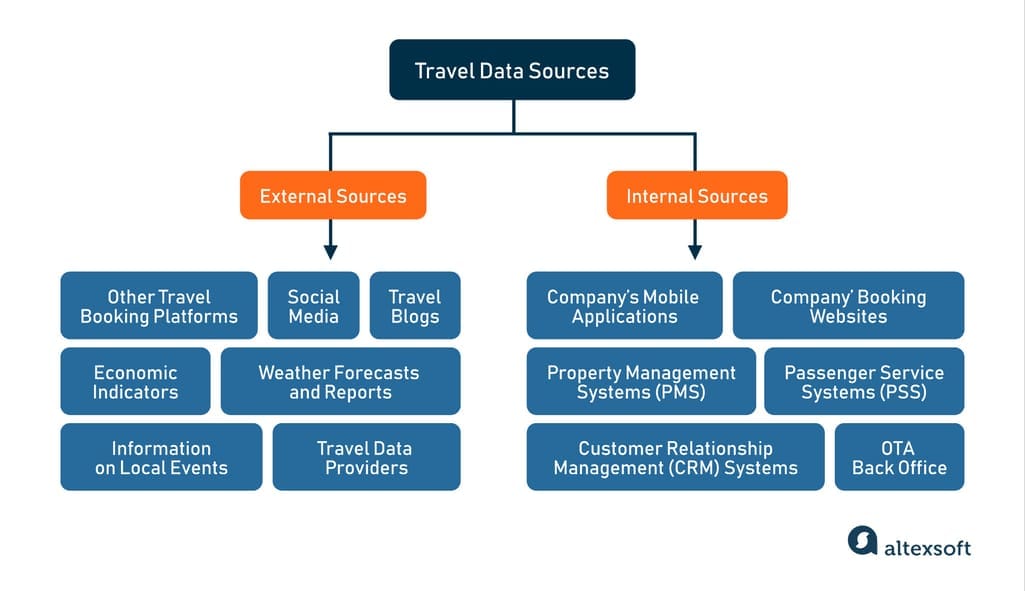
Internal travel data sources
Internal data refers to the proprietary information generated and collected by an organization as a result of its day-to-day operations and interactions with clients. It provides a comprehensive overview of a company's performance, highlighting both successes and areas needing improvement. By harnessing internal data sources, travel businesses can develop personalized services that cater to their customers' ever-evolving needs, as well as optimize their operations, enhance marketing strategies, and improve resource allocation, ultimately driving growth and profitability. Company’s booking website and mobile app allow you to track and collect a wealth of data, from web traffic information to user behavioral metrics (session duration, navigation paths, etc.), geolocation, profiles, and feedback. Internal systems — like a property management system (PMS) in hospitality, a passenger service system (PSS) used by airlines, or an OTA back office — are the backbone and the most relevant source of transaction details, booking histories, and inventory data for a travel business. Learn more about the functions of internal systems with our dedicated articles about hotel property management systems and passenger service systems . Customer relationship management (CRM) systems contain customer profiles with demographic information like age, gender, location, travel preferences, contact information, and communication history. They record and track customer and company interactions, spanning various communication channels like emails, chats, and phone calls. Loyalty program data can also be part of CRM records with information on membership tiers or rewards earned.
External travel data sources and providers
External data encompasses all types of information and datasets created outside a company and existing beyond its direct control, ownership, or management. Analyzing external data helps travel businesses stay competitive, adapt to shifting market conditions, and make well-informed choices regarding pricing, promotion, and overall strategies. Other travel booking platforms are the main source of information on competitors' offerings. By monitoring and comparing them, you can identify popular services, destinations, and accommodations. This approach culminates in inventory optimization and competitive pricing strategies. Social media and travel blogs contain valuable information about travelers' experiences, recommendations, preferences, and popular upcoming events. These online platforms include customer reviews and user comments, covering everything from current trends to destination-specific information. Economic indicators cover a wide range of statistics that reflect the economic state of a region, country, or industry. They can be indicators of inflation, exchange rates, unemployment, and consumer spending. For the travel industry, this data is essential for understanding economic conditions that can impact travel patterns and consumer behavior. Travel data providers offer a diverse range of ready-to-use data for hotels, travel agencies, and other stakeholders . For instance, a notable expert in this domain, OAG , has a suite of air-related datasets, including historical flight data spanning 20 years. Businesses selling vacation rentals can take advantage of data collection from AirDNA , Mashvisor , and others. Read our article to find a more detailed exploration of short-term and vacation rental data . Other external data sources that can be helpful when building travel analytics solutions are weather forecasts and reports, and information on events that take place in a particular location.
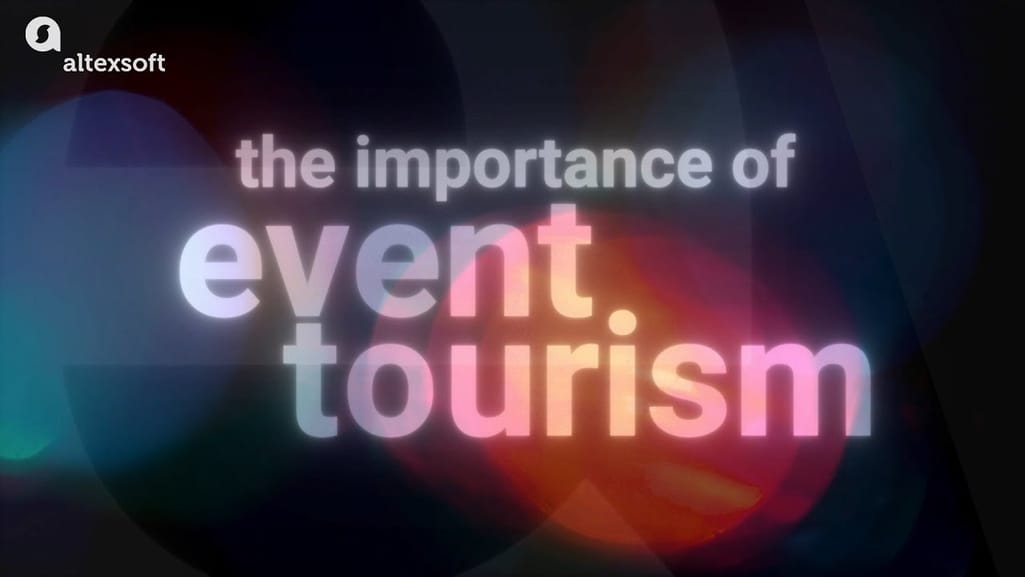
The importance of the events economy in the travel industry.
4 travel analytics use cases
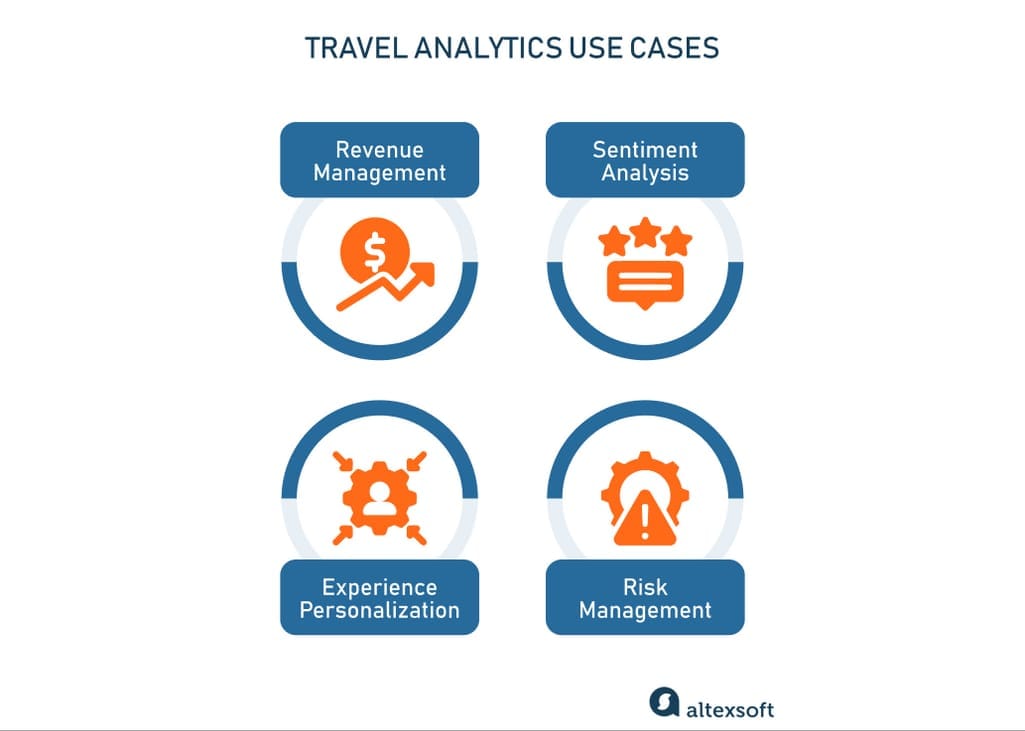
4 travel analytics use cases.
1. Revenue management
Revenue management is a set of practices for maximizing revenue by setting optimal prices based on demand. Many factors should be considered to find the right balance between rates and current seat availability, room occupancy levels, etc. That’s where modern analytical methods can help you out. Demand forecasting with machine learning allows companies to spot the slightest shifts in consumer behavior and predict a probable future demand for a product or service. For instance, businesses can prepare for more customers when flight bookings intensify for a specific destination. They can adjust prices and create appealing travel packages. Read our dedicated article to learn more about demand forecasting methods . Price prediction empowers companies to maintain a competitive edge in the market by establishing optimal rates. Learn about our experience in building machine learning models for flight price prediction and hotel price prediction . Occupancy rate prediction is crucial for making data-based decisions on pricing strategy, planned maintenance, and staff scheduling. Accurate forecasts allow revenue managers to quickly identify periods of increased or decreased interest, for example, months in which rooms will be sold at a higher or lower price. To gain further insights on this topic, take a look at our article that discusses occupancy rate prediction using machine learning . Dynamic pricing is the process of setting the price of a product or service in response to current demand, market trends, and other factors. Demand forecasting, price prediction, and occupancy rate prediction can be part of a dynamic pricing approach, helping revenue managers maximize profits in ever-changing conditions.
2. Sentiment analysis
With the widespread adoption of social media, travelers often share their experiences and recommendations, providing businesses with information about customers’ perceptions and preferences. This data can be used to run sentiment analysis. Sentiment analysis employs natural language processing (NLP) , statistics, and machine learning to decipher emotions, opinions, and judgments in text by extracting subjective information. Also known as opinion mining, it categorizes sentiments as positive, negative, or neutral. This type of text analysis can pinpoint areas for adjustment and assist in making improvements in service quality and customer experience, ultimately enhancing the brand's reputation. Read our article about sentiment analysis in hotel reviews to learn how we generate instant feedback snapshots, enabling travelers to swiftly compare various options and make the optimal choice.
3. Personalizing customer experience
Over 70 percent of customers expect the companies they engage with to consider their unique needs and desires. By analyzing factors like age, goals, status, region, values, and interests, businesses can facilitate effective personalization strategies for the various consumer types. Recommender systems and trip planning tools are two popular examples of how analytics enable this process in travel. Recommender systems use machine learning algorithms to make real-time personalized offers that meet the needs of a particular traveler. They can also aid in sustainable travel by suggesting ways to reduce carbon emissions and mitigate over-tourism, offering places with fewer visitors. For a deeper understanding, read our article that covers recommender systems or watch our video about the main types of recommender systems.

Main types of recommender systems.
Trip planning is another example of how analytics drive personalization in travel. It can be viewed as an advanced recommender system that generates an itinerary and recommends the best order of places to visit based on a traveler’s preferences, behavior, and other data. While some platforms go no further than proposing accommodations or ticket booking, more advanced services offer comprehensive trip arrangements, saving both time and money.
4. Risk management
In the travel industry, challenges can arise from various unexpected events. It’s important to surveil such situations and spot potential disruptions. Fraud detection driven by analytics helps pinpoint subtle and hidden events in user behavior that can signal possible risks, such as fake bookings and chargebacks. To counter these risks, besides analytical tools, implement travel fraud prevention measures, including additional verification steps and raising the company staff's awareness of the fraud risk. Read our article on ML-assisted fraud detection or watch this video:

Fraud detection: Fighting financial crime with machine learning.
Guest screening is another application of travel analytics, involving the processing of guest information, booking details, and historical behavior patterns. In this examination, each reservation is assigned a risk score — a quantitative representation of the potential risk associated with that particular reservation. It takes into account factors such as the likelihood of property damage, the risk of non-payment, and the potential for illegal activities. Guest screening equips hoteliers with the insights needed to make informed decisions regarding reservation acceptance. Identifying potential issues before guests arrive enables you to create a secure environment and mitigate risks that can impact the property's safety, reputation, and financial stability. Flight arrival and departure time prediction is a powerful method for mitigating delay scenarios. Machine learning algorithms consider various factors like weather, arrival gates, aircraft type, and more, enabling airlines and ground handlers to better allocate gates, swap aircraft or crews on particular flights as needed, and thus minimize tarmac wait times. Predictive maintenance utilizes machine learning to process data from IoT sensors and detect early signs of equipment failures. Due to this analytical method, airlines, car rental companies, and other businesses can address small problems before they develop into costly damages. For example, in aviation, predictive maintenance reduces the need to pull the aircraft out of service, helps optimize repair schedules, prevents unexpected faults, and insures against flight delays.
Real-life examples of successful travel analytics implementation
Here, we're sharing real-life examples of notable brands leveraging analytics to achieve impressive results in customer engagement, cost reduction, and operational efficiency.
Marriott: Bringing more personalization to the loyalty program
Marriott International, headquartered in Bethesda, Maryland, is a renowned American multinational company that operates, franchises, and licenses a diverse portfolio of lodging options, including hotels, residential properties, and timeshares. Marriott began as an A&W Root Beer franchise in Washington, DC, in 1927. Thirty years later, the company expanded into the lodging industry, marking a significant milestone. To drive analytics, Mariotte partnered with IBM. After migrating to a modern data stack , Marriott deployed Db2 Warehouse on Cloud , which allowed IBM data scientists to map comprehensive customer data across all Marriott brands and build a travel experience platform that now powers Marriott Bonvoy, the industry's largest loyalty program with over 140 million members. Each time customers redeem their loyalty points, the platform gains more data to better understand those travelers and market to them in a more personalized way.
American Airlines: Optimizing operations and reducing fuel consumption
American Airlines, founded almost 100 years ago, has a deep-rooted legacy of pioneering achievements, launching the first major carrier loyalty program , and introducing airport lounges. Headquartered in Fort Worth, Texas, it is the largest airline globally in terms of scheduled passengers carried and revenue passenger miles, a metric used to measure the total miles traveled by paying passengers. After transitioning its data platform to Microsoft Azure, American Airlines got a specific focus on optimizing operational efficiency. At the heart of its analytical efforts is an intelligent gating program that leverages real-time data on routes and runways and automatically assigns the nearest available gate to arriving aircraft. This enabled significant reductions in taxi time and fuel consumption, saving up to 10 hours of taxi time per day and thousands of gallons of jet fuel per year. American Airlines also developed the Hub Efficiency Analytics Tool (HEAT), an ML-driven program implemented to minimize the impact of weather-related flight delays. It analyzes various data points, including weather conditions, customer connections, air traffic, and gate availability. HEAT's proficiency in dynamically adjusting departure and arrival times has decreased flight cancellations during adverse weather conditions. All told, American Airlines' strategic embrace of AI, machine learning, and data analytics has led to notable improvements in operational efficiency, customer experience, and cost reductions.
Hilton: Personalization with data-driven smart suggestions
Hilton Worldwide Holdings Inc. is a renowned American multinational hospitality company headquartered in McLean, Virginia. From its inception in 1919, Hilton's goal was to operate the finest hotel in Texas. Commitment to excellence and innovation has positioned it as one of the world's most respected brands that has grown to operate in over 100 countries. Recognizing the growing importance of data in hospitality, the company is constantly investing in analytics to stay ahead in an ever-evolving market. For example, Hilton implemented in-page data capture technology by Celebrus , to accurately capture the smallest details of customer behavior on hotel sites. It allows for a better understanding of visitors and enhances their experience. Hilton also benefits from OnQ CRM, a proprietary system developed to handle large amounts of diverse customer data collected through various communication channels. With predictive analytics, the company can use these large volumes of data to forecast customer retention and better meet guest demands. Incorporating advanced data analytics and innovative technologies, Hilton has not only solidified its position as one of the global hospitality leaders but has also demonstrated its commitment to an exceptional guest experience.
Agoda: Enhancing user journey with OpenText Analytics
Agoda, founded in 2005, has revolutionized travel by simplifying the search and booking process. This Singapore-based OTA operates globally and is considered one of Asia's leading travel-tech companies. With millions of registered customers and over 6,000 employees across 31 markets, Agoda offers access to over 2 million properties worldwide and a range of travel-related services. Every day, the company's website serves millions of customers, which makes a frictionless booking journey and overall usability a major competitive factor. “Customers will stick with us if we provide high-quality products and a streamlined experience, and accommodation owners will offer optimized pricing if we give them the best marketplace," Idan Zalzberg, VP Data at Agoda, explains . To stay ahead of rivals, Agoda employed Vertica Analytics Platform (now owned by OpenText.) It enabled the OTA to analyze complex user behavior patterns in seconds and constantly improve the website based on insights from large volumes of data.
How to approach travel data analytics
The process of unlocking valuable insights from data involves the following key steps. Assemble a data science team. Building or hiring a skilled data science team with expertise in the travel domain is a fundamental step to take before the process even begins. Pay attention to the collaboration and communication skills of the team members since they must interact a lot with other stakeholders and be on the same page with them. Formulate key questions. Clearly define the problem your organization is going to solve with the help of analytics. Establish measurable goals and KPIs to gauge the success of your efforts. Articulating the anticipated results is critical for ensuring that all stakeholders have a shared understanding of the project's purpose and direction. Define data sources and collection methods. The next crucial phase is to gather the necessary data for analysis. The choice of data sources and collection methods should align with business objectives to ensure that the analysis is based on accurate and relevant information. Define the timeframe for data collection and create a clear plan with information on team assignments, relevant data sources, and key requirements. Choose analytical tools. Depending on the nature of the data and your business objectives, a variety of techniques may be employed, including machine learning, deep learning , natural language processing (NLP), and computer vision . Discuss the most appropriate methods with your data science team. Communicate and visualize the results. This step ensures that stakeholders understand and can use the analytics results to make informed decisions. Engage with stakeholders in a way that resonates with their level of expertise and interest, maintaining clarity and transparency. To enhance effective storytelling, utilize BI tools like Power BI or Tableau, or Python libraries like Matplotlib and Seaborn. Read our article on data visualization libraries and tools to learn more. Consider implementing data governance. An effective data governance strategy ensures the accuracy, availability, and security of data, making it compliant with data regulations, such as the GDPR in the EU and CCPA in California. Data governance policies safeguard the company’s reputation and enhance both partner and customer trust. These steps are crucial to fully leverage the power of data in your travel operations and ensure that your business initiatives are geared towards making informed, customer-centric decisions.
Destination Insights with
Skip to Content
Keep up with the latest travel trends
Smart business decisions rely on good insights. Keep your finger on the pulse of ever-changing global travel demand trends with actionable data, updated daily. Check out some top insights for your country below, or use the filters to find the data most relevant to you.
1}" > Fastest-growing destination globally
1}" > country with the most inbound interest, top insights for your selected country.
- Inbound destination demand
- Outbound destination demand
- Global trends
1}" > Top 3 sources of inbound demand
1}" > top city in demand (internationally), 1}" > top city in demand (domestically), 1}" > inbound demand growth, 1}" > top 3 destinations for outbound demand, 1}" > top city in demand internationally, 1}" > demand growth for top international city, 1}" > demand growth for outbound travel, 1}" > top 3 countries for worldwide demand, 1}" > top 3 cities for worldwide demand, 1}" > country with fastest growing inbound demand, 1}" > city with fastest growing inbound demand, click into the details of travel demand.
Switch between understanding country-specific demand trends, and comparing flight and accommodation demand across countries. Use the filters to refine your search.
Country-specific travel demand
Use the tabs below to discover inbound and outbound demand trends for your selected origin and destination countries., trends in country demand, city and regional demand, growth of demand, sources of demand.
View the demand trend for travel from a selected origin to a selected destination.
- Tap on the chart for more details
- The chart is horizontally scrollable
Understand the relative popularity of cities in your selected destination country. For a broader view of popular destinations for travellers in your origin country, set your destination filter to ‘Worldwide’.
Top demand by destination area
- {{$index+1}} {{item.code}} {{item.queries}}
Top demand by destination country
- {{$index+1}} {{item.country.name}} {{item.queries}}
Top demand by destination location
Top demand by destination city
Understand how demand has shifted over time for your destination country, the area it belongs to, and the cities within it.
Top growth by destination area
- {{$index+1}} {{item.code}} {{item.growthScale}}
Top growth by destination country
- {{$index+1}} {{item.country.name}} {{item.growthScale}}
Top growth by destination location
Top growth by destination city
- -10% to 10%
- -10% to -25%
- -25% to -50%
- -50% to -75%
Find out where inbound demand for your selected destination is coming from.
TOP DEMAND BY ORIGIN LOCATION
TOP DEMAND BY ORIGIN COUNTRY
- {{$index+1}} {{item.location}} {{item.queries}}
Visit Google Trends to learn more.
Comparative flight and accommodation demand data
See at a glance how different countries rank for accommodation and airline demand, with relation to inbound demand to and outbound demand from your primary country. use the filters above to select a primary country and up to 10 other countries to compare..
INBOUND INTEREST FROM SELECTED COUNTRIES TO PRIMARY COUNTRY
OUTBOUND INTEREST FROM PRIMARY COUNTRY TO SELECTED COUNTRIES
Explore these resources for additional insights
- Google Trends
Gauge consumer search behaviour over time on any topic.
- Grow with Google
Explore free training, tools and resources to grow your skills.
claim your spot on our free startup advisory program
Big Data Analytics in the Tourism and Travel Industry
Big data in the travel industry: be part of the industry's future, three types of big data analytics in tourism, sources of big data in tourism, key benefits of big data in travel, big data challenges in the tourism industry, how big data is used in the travel industry to augment profitability, big data in travel software development outstanding use cases by epam.

The Editorial Team of EPAM Startups & SMBs is an international collective of tech consultants, engineering managers and communications professionals who create, review and share their insights on business technology and project success tips.
Hire your winning team from the pool of our vetted big data engineers.
Despite COVID-19 pandemic restrictions, tourism is still a trendy business niche. There are well-known big players here like TripAdvisor, Booking.com, Airbnb, as well as small and medium-sized travel agencies who struggle daily to ensure their competitiveness and customer loyalty. Big data plays an essential role in achieving these goals, helping to understand customer needs better, analyze the current state of the market, and automate some work processes. We will discuss the role of big data in travel and tourism in more detail below and reveal how you can profit from using it in the travel and tourism industry, increase your profits, and optimize processes.
In tourism, as in many other business sectors, big data is responsible for accurate decision-making. Typically, they are involved in customer demand forecasting, service personalization, as well as travel marketing, and pricing strategies optimization.
Big data is often used in conjunction with artificial intelligence and machine learning, allowing analytics departments to find patterns in large streams of unstructured information automatically. For example, this combination of technologies makes it possible to determine which particular characteristics of hotels affect user satisfaction or understand, based on the history of trips, which destinations a customer is most likely to buy a ticket to.
In general, big data is usually not a stand-alone technology, as it requires additional methods for storing, structuring, and analyzing it. However, this is exactly what helps tourism business owners to understand their customers better and anticipate their needs.
Descriptive Analytics
Descriptive analytics works with both real time and historical customer data. Their analysis provides an objective assessment of what might happen in the near future. Particularly in tourism, this type of analytics will be useful for reducing costs (for example, selling last-minute discounted tours) and improving forecasting accuracy (for example, 80% of full-price sales or 50% of early booking sales).
Predictive Analytics
Travel companies use this type of analytics to identify long-term forecasts based on previous trends and patterns. For instance, predictive analytics helps find out what types of trips (study, business, romance, business travel, or health and wellness) and what geographic destinations will be the most popular next season.
Prescriptive Analytics
And finally, prescriptive analytics, a more advanced version of predictive analytics that uses simulation scenarios. This type of analytics not only generates forecasts, but also helps a travel company identify the most promising business strategies to maximize profits and reach customers.
UGC data (generated by users)
This abbreviation stands for User Generated Data. This is the cheapest data to obtain and includes textual data obtained from questionnaires and social networks, as well as photo data.
Device data (by devices)
This data is quite expensive to obtain (its cost depends on the territories covered and the period allocated for the study) and includes GPS data, mobile roaming data, Bluetooth data, etc.
Transaction data (by operations)
This source includes web search data, web page visit data, online booking data, etc. Typically, advanced web services such as Google Analytics are used to obtain this data.
BOOST YOUR BUSINESS IN TRAVEL USING BIG DATA
Consider working with EPAM Startups & SMBs to take advantage of our travel & hospitality software development services and the experience we’ve gained over decades. Reach out to our team and tell our experts about your project.
Finally, it’s time to segment the benefits that travel companies receive from big data.
Revenue management
Let’s start with revenue management. With the help of big data generated by users, you can optimize your costs and more accurately predict revenues – both in the short term (for local events) and in the long run. Thus, the level of profit becomes predictable (in particular, with a big data solution, you can calculate more precisely occupancy rates), and you expose yourself to less risk of unexpected costs.
Enhanced analytics
Big data in tourism involves the use of historical and real-time data. At the same time, standard analytical approaches use only historical one. This is why big data solutions are more effective at predicting when trends change dramatically (as was the case with the COVID-19 pandemic, for example).
Seasonal management
The ability to quickly process large amounts of information from your target audience determines the effectiveness of seasonal marketing and optimizes long-term forecasting. Thus, you do not have to act randomly when choosing new geographical destinations and tour formats.
Information brokers’ management (ex. TripAdvisor)
Instead of manually collecting information posted by well-known travel brokers (unfortunately, often with this approach, flight offers are already out of date at the time the offer is created), you can use a big data solution to automate and speed up the creation of new offers for your clients.
For the sake of objectivity of our review, we will also look at the challenges that big data solutions can face in the travel industry.
Privacy and security
Big data is being generated at a phenomenal rate that currently exceeds the ability to properly collect, process, store, and analyze this info for timely, meaningful use. In addition, traditional IT security systems are not flexible and scalable enough to protect this information. That's why it's so important to look for advanced solutions to secure your analytics data.
Data ownership
Since big data in the tourism industry comes directly from users and personal devices, it’s very important to provide full compliance with GDPR and HIPAA policies. This is necessary so that your users can easily and safely delete their info if they want to.
Data handling
Processing big data that comes in real-time requires special technologies (otherwise, this procedure will be too resource-intensive). Usually, for this, as we wrote above, machine learning and artificial intelligence are used.
Data storage
As a rule, to store big data for tourism, business owners use public cloud environments (for example, from giants such as Amazon, Microsoft, and Google) or private ones (this option is typical for the corporate segment) are used. As for storing your resources, it’s very expensive, because it requires the purchase of high-performance equipment.
How is big data being used in the travel industry? Now we propose you take a look at the examples of the big data application in this business niche.

Revenue optimization
Big data, based on the satisfaction of existing customers and future customers' expectations, helps get more accurate information about the potential profit. In particular, the pricing procedure is simplified due to the correct forecasting of peak periods of maximum demand, as well as the relevance of services based on current market trends.
Reputation improving
In a time when almost everyone is eager to leave their opinion about any service on social networks, business owners should pay special attention to these reviews and work with reputation. For example, there are special reputation management services for analyzing the tone of voice, which determine the average opinion about a particular subject of research as a whole.
Strategic marketing
Big data is dates and numbers related to those dates. Together, this information can be used to accurately predict and model future business strategies. As a rule, to create such models, additional tools based on artificial intelligence are needed.
Personalization of the customer experience
Big data can help you understand how your customers think and what exactly they want. Moreover, thanks to forecasting tools, you will be able to predict their future needs caused by new popular trends in tourism.
Marketing research
Big data helps you collect information about your competitors and your target audience based on last year's or even older reports, but in real-time. No other technology will give you the same precision in your research.
Targeted marketing
Given the diversity of customers who may contact you, it will probably be difficult for you to develop a single target marketing strategy for attracting and retaining them. In turn, big data can analyze an infinite number of representatives of your target audience, segment them into groups, and thus help create a targeted approach to each type.
EPAM Startups & SMBs, a cooperation platform launched by the global software development company EPAM, focuses on cooperation with small and medium-sized businesses. EPAM Startups & SMBs allocates for each project top specialists who have had the experience of working with representatives of big business – for example, with companies from the Fortune 100 list. It’s noteworthy that the main implication of such an approach is to transfer the advanced methodologies and practices even to small projects with a limited budget.
As a result, absolutely all of EPAM Startups & SMBs clients receive a top product for their business niche, and we get another great cooperation experience.
Let's look at several case studies out of EPAM's portfolio relevant to the travel industry and big data. You can also read more about our big data development services .
Connect@Changi
Connect@Changi is the world’s first pilot business travel exchange facility, located in Singapore. EPAM was appointed as a partner of the project for:
- providing a seamless experience for business travelers that lessens their time spent in COVID-19 quarantine;
- simplifying the unfamiliar travel process;
- granting the guests the much-needed assurance, etc.
As a result, EPAM delivered the prototyped project in just four months and became a winner in the ‘Business Travel Technology’ category at the 2021 Singapore Business Review International Business Awards.
Thanks to the collaboration, Connect@Changi achieved the following results:
- 120 current bookings;
- 425 app downloads on iOS and Android;
- 1,595 web visits to connectatchangi.com.
TUI Group is a multinational travel and tourism company, based in Hanover. At some point, its decentralized asset database has stopped meeting business needs. In particular:
- manual content submission processes were neither connected with upstream systems nor uniform with taxonomy and metadata requirements;
- deterioration of content quality from country to country, as there were no standards for digital assets or a way to reuse content from one country to the next;
- partners were unable to conveniently and effectively advertise their travel offerings.
This travel and big data solution with a new upload tool using ADAM/Hybris has these key features:
- centralized asset storage for the multiregional company;
- unified solution for asset management, gathering, and distribution;
- built-in approval, rights management, and licensing workflows for the uploaded assets;
- storage of different types of content, including images, photos, documents, videos, presentations, etc.
The company’s digital solution received such results:
- storing of 1,200,000 assets in total;
- using in 10+ locations worldwide;
- import and export of thousands of assets per month.
Southwest Airlines
In 2017, Southwest Airlines decided to collaborate with EPAM to improve the in-airport customer experience, so travelers could get to their destination without worrying about the journey. The main challenges of existing digital solution were:
- lack of clear and accurate information;
- excessive gate crowding;
- lack of meaningful customer service.
To fix them, EPAM built a new digital wayfinding system for the customers. The team also redesigned all of the existing airport signage and added new sign types at key locations throughout the airport. As a result, 96% of customers said the new signs made it easier to navigate the airport, and customers rated the usefulness of the new system as 4.77 on a 5-point scale.
HIRE EPAM STARTUPS & SMBS TO OVERCOME BIG DATA CHALLENGES PROFESSIONALLY
Cooperating with our top talent, you can be sure that none of the above problems will overtake your project. Contact us, and we will discuss your goals in detail.
Let's summarize all the things we said about big data analytics in the tourism industry. As you can see, big data in the travel industry is not just another trend technology, but a tool for better understanding the market situation and each client in general (potential and existing). All this forms an excellent foundation for a more personalized approach and more accurate prediction of what customers want.
In particular, in the context of improving KPI indicators, big data has become a source of more accurate and up-to-date information about Net Promoter Score (NPS), Customer Satisfaction Score (CSAT), Social Share of Voice (SSoV), etc. This is why the use of big data, even in the first months, can significantly strengthen the competitive advantage of the tourism business.
Explore our Editorial Policy to learn more about our standards for content creation.

Big Data in eCommerce: Does it Cost a King's Ransom?

Big Data in the Telecom Industry: a Golden Harvest on the Digital Fields

How Big Data Analytics in Fintech Improves Customer Experience

How Business Intelligence in Retail Improves your P&L

Retail and Big Data: Transforming the Industry to Become a Leader

How Big Data Analytics in the Banking Industry Leads Your Business to Divergent Growth

SaaS Security: 18 Ways to Protect Your Product

How Much Does It Cost to Redesign a Website?

Your Ultimate Guide to Outsourcing QA Testing Services

Cloud-Based Ecommerce: Benefits, Top Platforms, and Migration Steps

ERP Integration With Ecommerce in 2024 Explained

Explaining the Power of LTV in Ecommerce

How to Improve Ecommerce Sales in 20 Steps

Ecommerce Outsourcing Services Guide

How to Improve Ecommerce Customer Experience

Guide to Business Development Services Outsourcing
Home › Travel Hospitality › A Guide to Data Analytics in the Travel Industry
A Guide to Data Analytics in the Travel Industry
Written by: Medha Banerjee
Introduction to data analytics in travel industry
Welcome to “Navigating the Data Highway: A Comprehensive Guide to Data Analytics in the Travel Industry,” where we unravel the transformative power of data in shaping our journeys. In today’s dynamic travel landscape, stakeholders across the industry are realizing that knowledge truly is power, and data serves as the fuel for informed decision-making.
In this exploration, we dive into how Big Data and advanced analytics are revolutionizing the way travel agencies and stakeholders operate. Every click, swipe, and booking leaves behind a digital footprint, and it’s through harnessing this data that the industry is experiencing unprecedented growth and efficiency.
From personalized experiences tailored to individual traveler preferences to predictive insights driving business growth, data analytics serves as the compass guiding the industry forward. Our journey begins with a deep dive into how Big Data, Customer Experience, Business Growth, Predictive Insights, Booking Trends, Traveler Preferences, Marketing Strategies, Travel Demand Forecasting, Personalized Services, Price Optimization, Customer Satisfaction, Data governance strategy, Data-driven business decisions, Data-driven travel experiences and Data-driven revenue optimization, optimized pricing strategies and data-driven marketing initiatives are maximizing marketing ROI and meeting traveler demands.
We’ll uncover how data-driven customer experiences are not just a luxury but a necessity in today’s competitive landscape. Through AI and ML algorithms, travel agencies can forecast travel demand, optimize pricing, and offer personalized services that enhance customer satisfaction and loyalty.
But with great power comes great responsibility. Data governance policies and strategies are essential to ensure the ethical and secure handling of personally identifiable information (PII). By implementing robust data governance frameworks and leveraging data intelligence platforms, stakeholders can make informed, data-driven decisions while safeguarding sensitive information.
Join us on this journey as we unveil the secrets and strategies that are reshaping the future of travel. Together, let’s navigate the data highway toward unparalleled operational efficiency, personalized experiences, and sustainable growth in the travel industry.
Book a demo to experience the meaningful insights we derive from data through our data analytics tools and platform capabilities. Schedule a demo today!
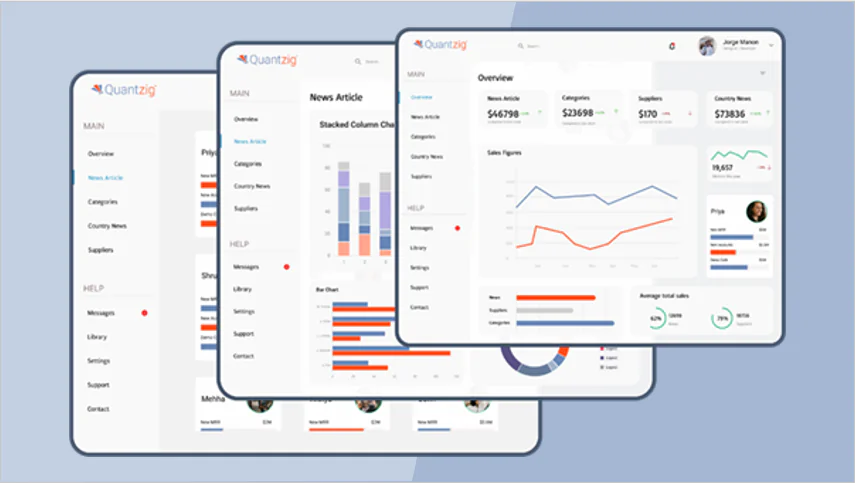
Importance of Data Analytics in the Travel Industry:
The travel industry can leverage the power of enhanced Revenue Operations (RevOps) by delving into crucial factors like demand dynamics, pricing strategies, and competitor activity. In an environment characterized by fluctuating demand and dynamic market conditions, data-driven insights are paramount. By analyzing data on customer preferences, market trends, and historical booking patterns, businesses can make quicker, more informed decisions on pricing and promotional strategies.
RevOps enables companies to adapt to real-time changes in demand, fine-tune pricing models, and implement dynamic promotions. This agility allows travel businesses to maximize revenue while staying competitive in a fast-paced industry. Furthermore, the ability to respond swiftly to market shifts by Stakeholders, Travel Agencies, Big Data, Customer Experience, Business Growth, Personalized Experiences, Predictive Insights, Optimized Pricing, Marketing ROI, Booking Trends, Traveler Preferences, Marketing Strategies, Travel Demand Forecasting, Personalized Services, Price Optimization, Customer Satisfaction enhances profitability, customer satisfaction, and overall operational efficiency, making data-driven RevOps a vital asset for success in the travel sector .
Incorporating AI and ML technologies, along with a robust data governance strategy and policies safeguarding PII, travel businesses can create a robust data intelligence platform. This platform empowers them to make data-driven business decisions, leading to enhanced operational efficiency and revenue optimization. Moreover, leveraging data-driven insights facilitates the creation of personalized, data-driven travel experiences, enriching customer satisfaction and loyalty. By embracing data-driven revenue optimization, Data governance strategy, Data intelligence platform and ata-driven customer experiences, travel companies can thrive in a competitive landscape while ensuring adherence to stringent data governance policies.
Challenges faced while implementing Data Analytics in the Travel Industry:
The success of the travel industry is contingent on a holistic approach that prioritizes excellence before, during, and after the customer’s experience. To achieve this, the industry is increasingly recognizing the significance of Revenue Operations (RevOps), Stakeholders, Travel Agencies, Big Data, Customer Experience, Business Growth, Personalized Experiences, Predictive Insights, Optimized Pricing, Marketing ROI, Booking Trends, Traveler Preferences, Marketing Strategies, Travel Demand Forecasting, Personalized Services, Price Optimization, Customer Satisfaction in orchestrating seamless and efficient journeys.
Efficiently managing the different stages and constructing a high-performance RevOps framework is a crucial strategic endeavor for ensuring continual expansion. This endeavor necessitates a systematic overhaul, involving a fundamental change in operational efficiency. Central to this transformation is the implementation of advanced technologies such as AI and ML, alongside the establishment of robust data governance strategies and policies. Leveraging a sophisticated data intelligence platform, PII (personally identifiable information), Data governance policies, Data intelligence platform, Data-driven travel experiences, Data-driven revenue optimization and Data-driven customer experiences becomes imperative for making informed, data-driven business decisions and optimizing revenue streams. Moreover, it paves the way for delivering personalized travel experiences driven by data insights, thus enhancing customer satisfaction and overall business performance.
Excellence before the experience involves precise market analysis, pricing strategies, and demand forecasting to attract the right audience. During the experience, operations, service quality, and customer satisfaction are paramount. After the experience, post-trip engagement, loyalty-building, and data-driven insights play a pivotal role.
RevOps serves as the linchpin connecting these phases, optimizing processes, pricing, and promotions, ultimately enhancing the overall guest journey in the travel industry. Programmatic transformation empowers the industry to adapt, innovate, and stay competitive in a rapidly evolving landscape, ensuring that travelers receive excellence at every stage of their journey. By integrating data analytics into decision-making processes, RevOps enables vendors, partners, and other stakeholders to understand the dynamics of the travel sector and the industries better. This insight allows for more informed decisions regarding pricing strategies, promotional campaigns, and resource allocation, ultimately leading to increased traveler revenue and improved customer experiences. Furthermore, it equips industry players with the necessary tools to navigate the complexities of the travel industry and capitalize on emerging opportunities.
Experience the advantages firsthand by testing a customized complimentary pilot designed to address your specific data analytics requirements. Pilot studies are non-committal in nature.
Benefits of implementing Data Analytics in the Travel Industry:
Our RevOps Solutions suite represents a transformative approach to handling data complexities within the travel industry. From the cockpit of your operations to advanced simulators, our suite is meticulously designed to streamline your data ecosystem. We enable actionable reporting and equip decision-makers with advanced analytics capabilities that empower them to navigate the dynamic landscape of the travel sector. With features such as dynamic pricing and proactive strategies to address disruptions, our suite ensures that your company stays ahead of the curve. Additionally, we prioritize customer support to enhance satisfaction and foster loyalty. By leveraging Customer Support, Satisfactio, Companies, Oceans of Data insights from oceans of data, we help you optimize demand, refine services, and fine-tune operations to gain a competitive edge in the market.
Central to our approach is the deployment of highly efficient analytics engines that seamlessly integrate with your data infrastructure. These engines not only process data but also provide predictive and simulation capabilities, delivering insights in real-time or near-real time. This means that decision-makers have access to up-to-the-minute data, allowing them to make informed, data-driven decisions that can significantly impact revenue, customer satisfaction, and operational efficiency. In an industry as fast-paced and dynamic as travel, having the ability to make strategic decisions based on the latest data is a game-changer, and our RevOps Solutions suite makes it possible.
Customers benefit from these capabilities by receiving more personalized experiences, while businesses can identify trends and patterns in customer behavior to tailor their offerings accordingly. However, leveraging this data comes with its own set of challenges, including ensuring the sustainability of data practices and navigating the complex travel landscape.
Yet, amidst these challenges lie significant opportunities for improvement and innovation. By harnessing the power of data intelligence and embracing real-time insights, Table of Contents, Benefits, Types of Data, Sustainability Efforts, Improvement businesses can stay ahead of the curve and capitalize on emerging trends. Our suite of RevOps Solutions is designed to support these efforts, enabling organizations to adapt quickly to changing market conditions and drive sustainable growth.
Get started with your complimentary trial today and delve into our platform without any obligations. Explore our wide range of customized, data analytics solutions built across the analytical maturity levels.
Success Story:
“Transforming Travel Excellence: How Quantzig’s Data Analytics Guide Supercharged Client Success”
Client details:
The Client is a Leading Hotel Chain based out of the US that operates multi-brand hotels across the country.
Challenges faced by the client:
The objective of our client was to find an integrated solution that could effectively address performance measurement, streamline operational processes, and enhance decision-making support. The primary goal was to establish a cohesive framework that enabled comprehensive data analysis, allowing the organization to gauge performance, identify areas for improvement, and make data-driven decisions. By implementing this connected solution, the company aimed to optimize its operations, increase efficiency, and ensure that decision-makers had access to real-time, actionable insights to drive strategic planning and growth.
To achieve this, the solution needed to encompass a wide range of data types, including Social Media Data, Geospatial Data, and External Data. Data Integration was crucial to consolidate these diverse data sources and manage the Data Volume effectively. Furthermore, the solution required capabilities for Real-time Data Processing to enable timely decision-making.
Once the data was collected and processed, Data Interpretation and data volume became essential to extract meaningful insights. However, it was equally important to ensure the Ethical Use of Data and Regulatory Compliance throughout the process, especially considering sensitive data such as PII.
Additionally, the integration of Mobile Roaming Data, Bluetooth Data, and Mobile Browser Data could provide valuable insights into customer behavior and preferences. However, this integration needed to be handled carefully to maintain Ethical Standards and comply with Regulatory Requirements.
Moreover, the implementation of such a solution would require effective Change Management to ensure smooth adoption and utilization across the organization. This would involve training employees on the new tools and processes and fostering a culture of data-driven decision-making at all levels of the organization. Ensuring data trustworthiness is paramount to mitigate risks such as data breaches and data privacy violations. By becoming a data-driven organization, businesses can harness data-driven strategies and data-driven insights to drive data-driven decisions and data-driven marketing initiatives, enabling the creation of targeted data-driven marketing segments.
Solutions offered by Quantzig:
Our RevOps solution is a pioneering system that seamlessly integrates performance data across the entire customer journey, encompassing the stages before, during, and after the trip. This holistic approach offers a comprehensive understanding of the entire value chain. To enhance decision-making, our solution provides a cohort of dashboards, each tailored to a specific stage of the customer journey. These dashboards act as strategic command centers, offering real-time insights and in-depth analytics.
A key feature is our root cause analysis components, which are embedded within the dashboards. These components excel at identifying variances in performance metrics and swiftly provide remediation recommendations directly within the dashboard interface. This dynamic functionality empowers businesses to not only track their key performance indicators but also proactively address issues, optimize processes, and enhance the customer experience throughout the journey.
In a rapidly evolving industry, our RevOps solution acts as a lighthouse, guiding businesses towards data-driven, performance-boosting strategies and decision-making, ultimately driving growth and excellence.
Impact delivered:
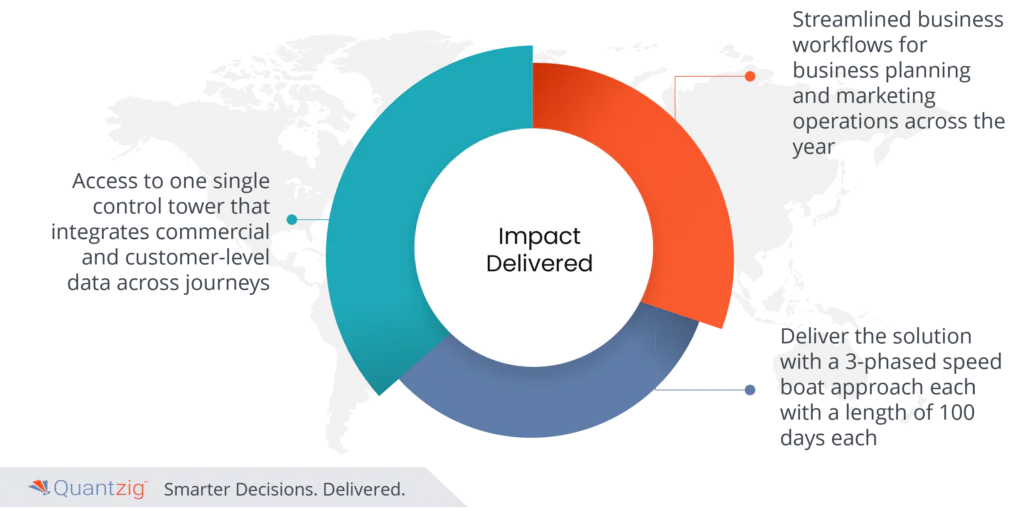
The client now has access to one single control tower that integrates both commercial and customer-level data across journeys, facilitated by a robust data governance framework. Quantzig was able to deliver the solution with a 3-phased speed boat approach each with a length of 100 days each. This integration eliminates data silos and ensures data security, promoting a data culture of transparency and accountability. Furthermore, it addresses data access management and data privacy, adhering to stringent data ethics standards. Additionally, it mitigates issues such as data duplication and enhances data quality through the implementation of a comprehensive data catalog and data management protocols. Leveraging tools like Google Analytics aids in data discovery and enables informed decision-making based on accurate insights.
In the ever-evolving realm of travel, data analytics emerges as the guiding compass, transforming the industry in unprecedented ways. As we conclude our guide to Data Analytics in the Travel Industry, we’ve unveiled the immense potential of data-driven insights in optimizing every aspect of the traveler’s journey. From personalized itineraries to responsive pricing strategies and enhanced customer experiences, data analytics has become the heartbeat of a vibrant and adaptive sector. It empowers decision-makers with the tools they need to navigate the dynamic landscape of travel, ultimately reshaping the way we explore the world.
In this data-driven paradigm, information sources such as Booking Data, Customer Reviews, Market Trends, and Social Media Interactions serve as invaluable assets, providing rich insights into traveler preferences and behaviors. Furthermore, real-time data streams such as Real-time Flight Data and Accommodation Data enable agile decision-making and timely adjustments to meet evolving demands.
The integration of Risk Management and Strategic Planning into data analytics frameworks enhances operational resilience and foresight, mitigating potential disruptions and optimizing resource allocation. Moreover, understanding various Data Types, including Personal Information, Travel History, Transaction Data, and Customer Feedback, allows for tailored experiences that resonate with individual preferences and needs.
By harnessing Behavioral Data and Loyalty Program Data, travel companies can foster lasting relationships with customers, driving loyalty and repeat business. Ultimately, data analytics empowers the industry to deliver on its promise of excellence, efficiency, and seamless discovery, ensuring that travelers embark on journeys defined by unparalleled experiences and enduring memories.
How is data analytics used in travel industry?
Data analytics is used in the travel industry to optimize pricing strategies, forecast demand, personalize marketing efforts, improve customer service, and enhance operational efficiency.
What types of data are analyzed in the travel industry?
In the travel industry, various types of data are analyzed, including booking data, customer demographics, travel preferences, website interactions, social media sentiments, competitive pricing data, and historical travel patterns.
What tools and technologies are used in data analytics for travel companies?
Travel companies use a range of tools and technologies for data analytics, including data visualization tools (such as Tableau or Power BI), predictive analytics software (like SAS or IBM SPSS), big data platforms (such as Hadoop or Spark), customer relationship management (CRM) systems, and machine learning algorithms.
How does data analytics benefit travelers?
Data analytics benefits travelers by enabling personalized recommendations, better travel planning assistance, real-time updates on flight and accommodation availability, improved customer service, and potentially lower prices through dynamic pricing models.
Recent Posts

Unlocking Value: Top Digital Transformation Trends

The Role of Analytics in Fighting Insurance Fraud

Benefits of HR Analytics For Your Business
Privacy overview.
tableau.com is not available in your region.

@2024 Voyage Labs . All Rights Reserved.
A Comprehensive Guide to Travel Analytics for Agencies and Corporate Travel Managers
Key takeaways.
- Travel analytics empowers agencies and corporate travel managers to make informed, data-driven decisions, optimizing operations and enhancing customer experiences in a dynamic industry.
- For those considering the development of a custom analytics stack, incorporating data integration tools such as Apache Nifi and Talend, along with BI software like Tableau and Looker, and leveraging AI technologies like TensorFlow provides flexibility tailored to the specific needs of the travel sector.
- Amadeus Agency Insight, Sabre Data & Analytics, TravelPerk, and Traxo are vital platforms for travel agencies and corporate travel management, providing professionals with a holistic understanding of performance and enabling informed, data-driven decisions beyond traditional metrics.
In the dynamic world of travel, where every journey weaves a distinctive tale, and each itinerary unfolds as an unwritten chapter, the pivotal role of data-driven decision-making emerges as a guiding beacon for businesses venturing into new horizons. Welcome to our thorough exploration of travel analytics—a sphere where insights derived from data act as catalysts for well-informed choices, operational excellence, and unmatched customer experiences.
Beyond a mere tool, travel analytics is a visionary force reshaping how the travel industry navigates challenges and capitalizes on opportunities. It involves deciphering meaningful patterns from expansive data sets, providing a roadmap for agencies and managers to base decisions on tangible data rather than intuition.
Embark on an insightful journey as we delve into the foundational aspects of travel analytics. From understanding the types of analytics shaping the industry to exploring key metrics, data sources, and premier software solutions, our guide is intricately crafted for travel agencies and corporate travel managers seeking insights and a comprehensive understanding of the data landscape.
The purpose is clear: to equip you with the knowledge and tools essential for thriving in an era where data goes beyond being a mere asset to become a strategic ally. Whether you are a seasoned professional navigating the intricacies of the travel industry or a newcomer eager to grasp the reins of data-driven decision-making, this guide serves as your comprehensive companion.
So, fasten your seatbelts as we navigate through the realms of travel analytics, illuminating the path to success in an industry where every data point holds significance.
- Why Businesses Need Travel Analytics
Businesses need travel analytics for many reasons, each contributing to optimizing corporate travel operations and overall business efficiency.
Travel analytics is vital for ensuring adherence to travel policies, enabling businesses to identify and rectify policy violations. Offering insights into booking data facilitates cost control, streamlining travel processes, and optimizing compliance with established policies.
Expense management is significantly enhanced through travel analytics. The cost-inflating factors like last-minute bookings, cancellations, and reschedules. Businesses with data analysis can make informed decisions to mitigate these expenses, leading to improved cost management.
Accurate and practical budgeting is essential for effective expense management. Travel analytics is a central repository for historical booking data, industry benchmarks, and real-time information. This allows finance teams to create realistic budgets that adapt to dynamic circumstances.
Travel analytics contributes to employee satisfaction by striking a harmonious balance between policy compliance and individual preferences. By tracking preference patterns and utilizing predictive analytics, businesses can provide travel options that align with employee preferences while adhering to company policies.
Knowing when and where to book accommodations at favorable rates is crucial for cost savings. Travel analytics provides insights into price fluctuations, enabling businesses to make informed decisions about selecting cost-effective vendors and optimizing their travel budgets.
Ensuring the safety of business travelers is a top priority. Travel analytics gathers real-time information on safety protocols, enabling businesses to make informed decisions and establish safety scorecards for different areas. This proactive approach reduces risks for travelers.
Sustainable travel is gaining prominence, and travel analytics equips companies with tools to monitor and reduce their carbon footprint. By generating real-time reports on environmental impact, businesses can make environmentally responsible choices regarding airlines, transportation, and accommodations.
Travel analytics is indispensable for businesses seeking to optimize corporate travel operations, control costs, improve policy compliance, enhance employee satisfaction, and prioritize safety and sustainability. The insights and data-driven decisions facilitated by travel analytics profoundly impact the bottom line, contributing to more efficient and responsible business travel practices.
- Types of Travel Analytics
Descriptive Analytics
Descriptive analytics constitutes the practice of scrutinizing historical data to attain a profound comprehension of the evolutionary trajectory of a business or industry. This analytical methodology entails an extensive retrospective examination of past data, facilitating substantive comparisons with preceding reporting periods, competitors within the same sector, and other pertinent benchmarks. Descriptive analytics yields pivotal financial metrics, including year-over-year (YOY) price oscillations, month-over-month sales growth, user metrics, and total revenue per subscriber, thereby affording valuable insights into a company's past performance during specific timeframes.
In the context of the travel industry, descriptive analytics holds notable relevance in its capacity to elucidate past travel trends. By dissecting historical data of variables such as booking patterns, travel destinations, pricing fluctuations, customer preferences, and seasonality, travel agencies, and corporate travel managers glean invaluable insights into the evolution of travel behaviors and trends.
This analytical process enables a comprehensive understanding of historical customer demand patterns, identification of peak travel seasons, and assessing how diverse factors, including economic shifts and global events, have influenced travel trends.
Concrete real-world illustrations of the advantages of descriptive analytics in the travel sector abound. For instance, a travel agency can harness years of booking data to identify perennially popular destinations during specific periods of the year.
This knowledge empowers them to proactively prepare for heightened demand, ensuring the availability of requisite resources, accommodations, and travel packages.
Descriptive analytics also plays an instrumental role in enabling travel managers to comprehend traveler preferences. By analyzing historical data regarding the categories of accommodations, amenities, and activities that customers consistently favor, travel agencies can fine-tune their offerings to align more closely with customer expectations.
Furthermore, examining customer reviews and feedback over time enables the identification of trends in customer satisfaction and areas requiring enhancement, thereby ensuring a more gratifying and personalized travel experience.
Descriptive analytics emerges as an indispensable instrument within the travel industry. It empowers businesses to gain insights into the historical evolution of travel trends, make informed decisions, and furnish customers with tailored and enhanced travel experiences.
Diagnostic Analytics
Diagnostic analytics is a pivotal component for organizations, offering profound insights into the causes of past performance trends. It surpasses superficial data analysis, delving deeply into historical data to answer the fundamental question: "Why did this happen?" This in-depth understanding empowers companies to make well-informed decisions and take precise actions, whether to replicate successes or effectively address and resolve issues. Diagnostic analytics also fosters a data-driven analytical culture, enhancing performance and improving decision-making.
Within the travel industry, practical applications of diagnostic analytics are evident:
When travel businesses experience sudden drops in online bookings, they can harness the power of diagnostic analytics to uncover the underlying causes. This analytical approach can unveil issues such as alterations in website design, performance bottlenecks, or external factors like travel advisories that impact booking numbers. With this knowledge, companies can take targeted actions to address these issues and boost their booking rates.
In the realm of travel, many destinations witness shifts in demand over a year. Diagnostic analytics plays a key role in helping travel businesses understand the factors driving these fluctuations. For example, suppose data analysis shows that a particular destination gains popularity in winter due to its excellent ski resorts, and in summer, it attracts beach enthusiasts. In that case, travel businesses can use this valuable insight to refine their strategies and cater to the unique preferences of travelers during each season.
Diagnostic analytics proves invaluable in uncovering why customers stop using a specific travel booking platform or airline. It may reveal issues linked to customer service quality, pricing strategies, or the availability of particular routes as influential factors driving customer churn. With this valuable insight, travel companies can formulate and implement strategies to improve customer retention and overall performance.
In practical scenarios, diagnostic analytics is an invaluable tool for the travel industry to make data-driven decisions and improve future outcomes.
Predictive Analytics
Predictive analytics, an advanced field within analytics, utilizes historical data analysis, statistical modeling, data mining, and machine learning to make informed predictions about future outcomes.
Closely associated with big data and data science, it leverages diverse data types from log files to images, dispersed across various repositories. The primary objective is to identify patterns, risks, and opportunities, allowing for the anticipation of future events.
In the realm of travel agencies and corporate travel, predictive analytics plays a crucial role. Travel agencies and CTMs employ it to enhance customer experience by offering personalized recommendations tailored to individual preferences. Predictive analytics assists in evaluating the effectiveness of marketing campaigns, facilitating strategic decision-making for budget allocation and maximizing impact.
CTMs utilize it to optimize travel plans, ensuring seamless experiences for business travelers and improving operational efficiency. Furthermore, predictive analytics supports travel agencies in responding to dynamic market conditions, enabling adaptive strategies based on real-time insights to stay competitive in an ever-changing landscape.
These applications underscore the effectiveness of predictive analytics in providing insights for personalized experiences, strategic marketing, efficient planning, and adaptive responses to market dynamics.
Prescriptive Analytics
Prescriptive analytics is an advanced branch of data analysis that goes beyond understanding the past or predicting the future. It provides actionable recommendations for improving operations and decision-making. In the travel industry, this powerful tool offers numerous advantages.
Travel companies can use prescriptive analytics to fine-tune accommodations, flights, and package pricing. The system recommends adjustments based on real-time demand, competitor pricing, and customer preferences, maximizing revenue.
Travel agencies can provide personalized travel packages by using prescriptive analytics. It analyzes individual preferences, booking history, and current market trends to recommend tailored packages that cater to each traveler's unique interests.
Travel agencies and CTMs can receive real-time recommendations during adverse conditions in regions prone to weather disruptions. These suggestions may include alternative travel options, rescheduling, and proactive communication to minimize disruptions and enhance customer satisfaction.
Prescriptive analytics supports sustainable decisions in the travel industry. Travel agencies and CTMs can benefit from receiving recommendations to bolster their sustainability initiatives. These suggestions involve optimizing travel plans, choosing eco-friendly accommodations, and encouraging travelers to make environmentally conscious choices, fostering a more sustainable travel industry.
Prescriptive analytics empowers the travel industry by combining historical and real-time data with predictive models to offer actionable recommendations. This results in improved efficiency, increased customer satisfaction, and a more sustainable approach to achieving business goals.
- Key Metrics for Travel Analytics
In travel analytics, several essential metrics are pivotal for making well-informed decisions, benefiting both travel agencies and corporate travel managers.
For Travel Agencies
In travel analytics, several pivotal metrics play a crucial role in guiding well-informed decisions, greatly benefiting travel agencies. These key metrics encompass:
- Customer Satisfaction Scores serve as significant indicators of customer feedback. Elevated satisfaction scores indicate positive customer experiences, while lower scores pinpoint areas that require improvement.
- Booking and Cancellation Rates are paramount for travel agencies, as elevated cancellation rates may signal issues related to offerings or pricing. Monitoring these rates is essential for informed decision-making.
- Revenue Growth and Profit Margins are critical financial metrics essential in assessing travel agencies' economic health and long-term sustainability. Continuous monitoring of these indicators enables agencies to make informed financial decisions and ensure ongoing success.
- The Cost per Traveler is closely monitored by travel agencies to efficiently optimize travel expenses, which is crucial in managing and controlling travel budgets effectively.
- Ensuring Travel Policy Compliance is essential for travel agencies, emphasizing the significance of customers adhering to established travel policies. It is a practice of paramount importance in the travel industry.
These key metrics collectively contribute to the foundation of successful travel analytics, empowering travel agencies to navigate their operational landscapes with precision and strategic foresight.
For Corporate Travel
- The Travel Policy Compliance Rate is determined by calculating the percentage of trips that align with the organization's travel policies. This metric is of great significance as it quantifies the extent of adherence to established travel guidelines, ensuring efficient cost management and conformity to organizational policies.
- The Real-Time Adjustment Response Time is measured as the average duration taken to promptly modify travel plans in response to disruptions, such as flight delays or cancellations. This metric is essential as it reflects travel management's agility and responsiveness in addressing unforeseen events.
- Insights from Travel Booking Platforms involve the analysis of data to derive insights into travel patterns, preferred accommodations, and booking trends. This metric is crucial as it supports the optimization of travel arrangements and facilitates negotiations with suppliers based on historical travel data.
- The Travel Advisory Adherence metric quantifies the percentage of trips where employees comply with travel advisories and security alerts. This is vital for ensuring the safety of employees during corporate travels by monitoring adherence to travel advisories.
- The Negotiated Rate and Terms Improvement metric measures the percentage improvement in rates and terms negotiated with travel suppliers. This quantifies the effectiveness of negotiations with airlines and hotels, directly impacting overall travel costs.
- The Data Accuracy and Real-Time Updates metric assesses the accuracy rate of travel data and the frequency of real-time updates. This is crucial for ensuring data reliability in travel analytics, facilitating well-informed decisions, and enhancing customer experiences.
- Data Sources for Travel Analytics
Effective travel analytics relies on robust data sources that provide valuable insights for decision-making, whether for travel agencies or corporate travel managers. These data sources are essential in the travel analytics process.

Internal Data Sources
The company's booking website and mobile app capture valuable data, including web traffic, user behavior metrics, geolocation, user profiles, and feedback. This data aims to gain deeper insights into customer interactions, preferences, and feedback. Furthermore, it plays a pivotal role in enhancing the overall performance of the website and app, ultimately enabling the provision of highly personalized services to customers.
Internal systems, such as Property Management Systems (PMS), Passenger Service Systems (PSS), and Online Travel Agency (OTA) back offices, capture essential data comprising transaction details, booking histories, and inventory data. This data aims to facilitate the efficient management of bookings, the optimization of inventory, and the streamlining of overall operations within the travel agency.
Customer Relationship Management (CRM) systems collect a wide array of data, encompassing customer profiles, demographic information, communication history, and loyalty program data. This valuable data is harnessed to customize services, nurture robust customer relationships, and deploy precise marketing strategies effectively.
External Data Sources
Competitor booking platforms provide access to data about competitors' offerings, including popular services and destinations. This data is invaluable for refining inventory management and pricing strategies, ensuring that a travel business remains competitive and maintains relevance in the market.
Social media and travel blogs are rich data sources, offering insights into travelers' experiences, recommendations, preferences, customer reviews, and destination-specific information. This data is instrumental in assessing customer sentiment, monitoring travel trends, and gaining valuable destination-specific insights for travel businesses.
Economic indicators include inflation, exchange rates, unemployment, and consumer spending. These data sources are crucial for understanding the economic conditions that impact travel patterns and consumer behavior within the travel industry.
Travel data providers offer specialized data across various facets of the travel industry, including historical flight and vacation rental data. This data is a valuable resource for obtaining ready-to-use information that greatly facilitates informed decision-making and the development of effective strategies within the travel business.
Employee expense reports capture information about travel expenses, including receipts and approvals. This data serves the critical purpose of efficiently managing and optimizing corporate travel expenses, ensuring compliance with policies, and exercising cost control within the organization.
Travel policy compliance data records information that indicates the extent to which employees adhere to travel policies. This data is instrumental in enforcing travel policies, strengthening cost control measures, and prioritizing the safety and well-being of travelers within the corporate travel framework.
Employee feedback encompasses input provided by employees regarding their business travel experiences. This data plays a pivotal role in enhancing the overall corporate travel experience, addressing concerns effectively, and making well-informed decisions about future travel arrangements within the organization.
Competitor travel data comprises insights into competitor travel management practices, trends, and offerings. This data is vital for businesses to remain competitive and make agile adjustments to their corporate travel strategies, ensuring they stay practical and relevant in the market.
Social media and travel blogs provide access to travelers' experiences, recommendations, and customer reviews from various online platforms. This data is valuable for gathering insights into traveler preferences, monitoring travel trends, and accessing destination-specific information, which helps businesses better cater to their customers' needs and preferences.
Economic indicators encompass statistics like inflation, exchange rates, and consumer spending. These data sources are crucial for comprehending the economic conditions that impact business travel and corporate travel patterns, enabling businesses to make informed decisions in response to economic fluctuations.
Travel data providers offer specialized corporate travel data, including flight and hotel information. This data is essential for accessing tailored information that significantly aids corporate travel management and facilitates well-informed decision-making within the organization.
Incorporating data from these varied sources equips travel agencies and corporate travel managers to make data-driven decisions, enhance customer or employee experiences, and adapt to evolving market conditions.
- The Best Travel Analytics Software
Effective travel analytics is crucial for both travel agencies and corporate travel managers. Reliable software is pivotal in streamlining operations, facilitating data-driven decisions, and enhancing overall travel management. Let's explore the top options for travel analytics software in both sectors.
Amadeus Agency Insight
Amadeus Agency Insight provides a comprehensive suite of tools, encompassing performance analytics, competitor benchmarking, customizable reporting, identifying market expansion opportunities, and acquiring in-depth customer insights.
These features give travel agencies a robust platform for gaining profound insights into their business and the broader market. This, in turn, enables data-driven decision-making and the refinement of services to cater to specific requirements.
Amadeus Agency Insight plays a pivotal role in preserving the competitiveness of travel agencies. It achieves this by facilitating direct comparisons with industry rivals and adapting to the ever-changing landscape of market trends.
Consequently, the software empowers travel agencies to offer finely tuned services to their customers' preferences. The result is elevated customer satisfaction, increased revenue, and the capacity to make well-informed decisions that propel business success.
Sabre Agency Data & Analytics
Sabre Agency Data & Analytics offers comprehensive functions, including data visualization, forecasting, predictive analysis, market intelligence, efficiency enhancement, and pricing strategy refinement. Its data visualization tools simplify interpreting data, while the forecasting and predictive analysis capabilities enable proactive decision-making.
Market intelligence ensures that agencies stay updated with industry trends, and efficiency improvements streamline operational processes. The pricing strategy enhancement feature guarantees competitiveness in the market.
Leveraging Sabre Agency Data & Analytics empowers travel agencies to expedite decision-making, enhance service quality, and optimize resource allocation. The software assists in adapting to dynamic market conditions while preserving a solid market presence.
Two robust solutions for travel agencies, Amadeus Agency Insight and Sabre Agency Data & Analytics, provide comprehensive analytics, competitor benchmarking, and customized reporting. Amadeus Agency Insight gathers customer insights and identifies opportunities for expanding into new markets.
Meanwhile, Sabre Agency Data & Analytics offers predictive analysis capabilities and features for refining pricing strategies. Travel agencies can use both tools to improve service and stay ahead of competitors.
TravelPerk serves as a comprehensive, all-in-one platform dedicated to corporate travel management. It facilitates the entire process, encompassing tasks from booking to expense management, policy adherence, and providing real-time travel information.
This integrated solution significantly enhances corporate travel efficiency, guaranteeing employees a seamless and optimal travel experience.
TravelPerk excels in simplifying the intricacies associated with corporate travel, resulting in time and resource savings for both corporate travel managers and employees.
The platform ensures stringent cost control through effective policy compliance and streamlined expense management. Additionally, it furnishes real-time travel data, empowering organizations to optimize their travel plans effectively.
Traxo serves as an advanced solution, streamlining corporate travel management through its capabilities in data aggregation, expense reporting, ensuring travel policy compliance, issuing real-time travel alerts, and facilitating seamless supplier integration.
Corporate travel managers can utilize the platform to derive valuable insights from aggregated data, enforce policy adherence, and efficiently overseas travel expenses.
The integration of real-time travel alerts ensures that travelers are promptly informed, while supplier integration supports negotiations for improved rates and terms.
Traxo substantially benefits corporate entities by centralizing and providing accessible travel data for in-depth analysis and informed decision-making.
The platform significantly enhances cost control, ensures compliance with travel policies, and promotes operational efficiency within corporate travel management.
Real-world Examples of Traxo's Usage in Corporate Travel:
- Many companies use Traxo to centralize their travel data, allowing for better visibility and control over corporate travel expenses.
- Traxo's analytics tools enable managers to detect potential policy violations, negotiate better rates with preferred vendors, and optimize travel budgets.
- The platform has been instrumental in helping organizations enhance their corporate travel programs by providing actionable insights derived from data analytics.
In the realm of corporate travel management, both TravelPerk and Traxo present tailored solutions. While TravelPerk distinguishes itself with an encompassing, all-in-one approach that streamlines the entire travel management process—from booking to real-time travel information provision—Traxo prioritizes data aggregation and expense reporting, fostering centralized data access, policy compliance, and seamless supplier integration.
TravelPerk places a pivotal emphasis on delivering a seamless travel experience for employees by simplifying complexities across the entire travel journey. In contrast, Traxo excels in its dedication to centralizing data, ensuring rigorous policy adherence, and facilitating efficient negotiation with suppliers. These attributes collectively contribute to establishing a robust and well-controlled corporate travel management system.
Dependable travel analytics software facilitates well-informed decision-making, streamlining operations, and enhances the overall travel experience for both travel agencies and corporate travel managers.
The software solutions, encompassing Amadeus Agency Insight, Sabre Agency Data & Analytics, TravelPerk, and Traxo, have been carefully designed to address the distinctive requirements of these sectors, ultimately contributing to more efficient and cost-effective travel management.
- Tools for Travel Analytics
Data Integration Tools
Data integration tools are fundamental components of a robust travel analytics stack, serving as the cornerstone for consolidating diverse data sources within the travel industry. Their pivotal role lies in streamlining the collection, transformation, and unification of data from various systems, ensuring the creation of a cohesive dataset for comprehensive analysis. In building a custom analytics stack, these tools act as catalysts for establishing a seamless flow of information, enabling companies to leverage their data resources fully.
Here are the Data Integration Tools suitable for Travel Agencies and Corporate Travel:
Apache Nifi
- Role in Travel Analytics: Apache NiFi plays a crucial role in data ingestion and integration in travel analytics, collecting diverse data from sources like booking platforms and social media. With low-latency and high-throughput capabilities, NiFi enables real-time data processing for timely insights into travel patterns and customer behavior.
Its extensible design supports data transformation and enrichment, ensuring data quality. NiFi's data provenance tracking provides a thorough information lineage, crucial for tracking data history and ensuring compliance. Its commitment to secure communication aligns with the paramount need for data security in travel analytics, ensuring encrypted communication and adherence to access policies.
- Suitability: Apache NiFi is an optimal solution for travel analytics, featuring a scalable and extensible architecture adept at efficiently managing dynamic travel-related data. Its low-latency capabilities enable real-time analytics, ensuring prompt processing for swift decision-making in the dynamic travel sector.
NiFi's inherent features for data provenance and lineage guarantee data quality and transparency throughout the analytics pipeline. Its extensible design allows the customization of workflows, offering flexibility for organizations to tailor processes to specific requirements in travel analytics. Furthermore, NiFi's robust security support addresses the sensitive nature of travel data, ensuring privacy and compliance with security standards.
- Role in Travel Analytics: Talend assumes a crucial role in travel analytics by effectively integrating and processing diverse data sources, facilitating real-time decision-making. Its adaptability in custom attribute creation addresses evolving requirements, enhancing analytics customization.
Talend excels in managing resources and inventory, optimizing usage, and mitigating shortages. In targeted marketing, it discerns pertinent promotions for specific demographics, refining precision. Talend expedites decision-making in the dynamic travel sector by providing current information nurturing a culture of continuous improvement.
- Suitability: Talend is an optimal solution for travel analytics, presenting a cloud-based, scalable, and user-friendly platform with robust support for custom attributes. Aligned with industry demands for flexibility, it facilitates seamless cloud hosting, eliminating the necessity for supplementary infrastructure.
Talend's scalability empowers organizations to respond to evolving data needs and efficiently manage expanding volumes. Its user-friendly interface ensures accessibility across diverse user profiles.
The platform's adept support for custom attributes enhances its appropriateness for addressing varied data requirements within the dynamic realm of travel analytics, establishing Talend as a preferred choice for tailored solutions in this domain.
Informatica
- Role in Travel Analytics: Informatica is pivotal in travel analytics, seamlessly integrating diverse tourism data sources and strategically addressing operational efficiency through automated tools. Beyond data processing, it provides a unified and scalable cloud-native platform, automating critical data processes to manage tourism data efficiently.
The Informatica Cloud Application Programming Interface (API) Manager facilitates seamless data exchange, fostering collaboration among stakeholders in the travel analytics ecosystem, with notable data quality and anomaly detection strengths. Offering a 360-degree view of visitors, Informatica informs strategic decisions in the dynamic travel industry. Empowering organizations with self-service data discovery, it expeditiously defines key performance indicators (KPIs) and transforms data, enhancing productivity.
The platform's zero-code interface accelerates time-to-market, facilitating swift adaptation to changing data needs in the competitive landscape of travel analytics. As a pioneer in advanced analytics and artificial intelligence (AI) adoption, Informatica's Intelligent Data Management Cloud (IDMC) leverages machine learning to forecast essential metrics, adding sophistication to predictive analytics.
Moreover, by improving data trust, Informatica positions organizations as reliable data providers for government and private entities focused on culture and tourism. In essence, Informatica is a comprehensive solution, redefining the landscape of travel analytics with its multifaceted capabilities.
- Suitability: Informatica stands out as an excellent solution for travel analytics, boasting a comprehensive set of features tailored to address the dynamic challenges of the industry. Its proficiency in data integration, operational efficiency, unified data management, API management, data quality, and advanced analytics align seamlessly with the intricate demands of tourism data analytics.
The platform's adoption of a cloud-native architecture, scalability, and user-friendly interfaces positions it as the optimal choice for organizations seeking efficient, reliable, and innovative solutions in the travel analytics domain.
Informatica's ability to effectively address challenges in data maturity and deliver prompt results, ensuring a substantial return on investment, further underscores its suitability for driving transformative processes in tourism data analytics.
BI Software
Business Intelligence (BI) software is essential in travel analytics as it empowers organizations to convert raw data into actionable insights. In the travel industry, dealing with substantial data volumes, BI software facilitates the analysis of key metrics, trends, and performance indicators. It provides real-time reporting and visualization capabilities, enabling prompt, data-driven decisions for travel agencies and corporate travel managers.
The ability to aggregate and interpret data from various sources enhances strategic planning, optimizes operations, and improves customer experiences within the travel sector.
Here are the BI Software options for Agencies and Corporate Travel Managers:
- Role in Travel Analytics: Tableau plays a pivotal role in travel analytics by seamlessly integrating diverse data supporting informed decision-making with a comprehensive view. It enhances operational efficiency through quick data blending and linking, optimizing routes, and improving visibility for efficient inventory and capacity management.
Notably, Tableau promotes a data-driven culture, as evidenced by Southwest Airlines, empowering users in self-service analytics. In transportation and logistics, exemplified by Werner Enterprises, Tableau's visualization capabilities revolutionize the industry by unifying data for actionable insights. Tableau is a versatile solution, reshaping travel analytics with its integral roles.
- Suitability: Tableau is an optimal solution for travel analytics, distinguished by its rapid blending and linking of similar data, offering organizations comprehensive insights into customer behaviors and experiences.
Its efficacy in enhancing operational efficiency, providing real-time inventory visibility, and supporting revenue management and yield optimization aligns seamlessly with the dynamic challenges of the travel and transportation sectors.
Tableau's role in fostering a data-driven culture and promoting self-service analytics enhances its suitability for organizations seeking to empower users and derive valuable insights. The platform's versatility in creating custom views and decision-ready visualizations further reinforces its appropriateness for transforming analytics processes within the travel industry.
- Role in Travel Analytics: Looker is vital in travel analytics, serving as a potent tool for organizational business intelligence. It provides access, analysis, and actionable insights based on current and reliable data. Additionally, Looker contributes to developing tailored embedded analytics applications, offering benefits to travel agencies by seamlessly integrating analytics into customer-facing applications.
The platform's expertise in data modeling plays a crucial role in unifying business metrics across diverse teams, ensuring consistency in essential metrics related to booking trends, customer satisfaction, and operational performance. Looker Studio further empowers users in the travel analytics domain with robust self-service business intelligence, facilitating data visualization and sharing actionable insights.
As we look to the future, Looker positions itself at the forefront of AI-powered business intelligence, aligning with the evolving needs of the travel industry for automated insights, predictive analytics, and enhanced decision support. This strategic alignment resonates with the industry's emphasis on optimizing operations and improving customer experiences through intelligent analytics solutions.
- Suitability: Looker proves highly suitable for travel analytics, offering versatile capabilities that address the diverse needs of the industry. The platform's organizational business intelligence functionalities provide real-time insights crucial for adapting to dynamic market conditions.
Looker's support for embedded analytics is particularly beneficial for travel agencies and platforms, facilitating the creation of tailored user experiences. The data modeling features ensure a unified source of truth for business metrics, contributing to enhanced data consistency.
The self-service business intelligence and AI-powered capabilities play a pivotal role in making insights actionable, enabling organizations to stay ahead in the competitive landscape of travel analytics. Overall, Looker's adaptability and emphasis on real-time, trusted data experiences position it as a valuable asset for organizations in the travel sector.
Microsoft Power BI
Role in Travel Analytics: Microsoft Power BI offers a comprehensive suite of BI tools, enabling practical analysis and visualization of travel data. Its seamless integration with various data sources enhances its utility in the travel industry.
Suitability: Power BI's versatility makes it suitable for companies focusing on customization. It offers robust integration features, facilitating its incorporation into tailored analytics stacks.
For companies that build custom analytics stacks, the key is to select BI software options that provide flexibility, scalability, and seamless integration into a customized analytics environment tailored to travel agencies and corporate travel managers' unique needs.
AI Technologies
In the travel industry, Artificial Intelligence (AI) has become essential for automating data analysis, identifying patterns, and providing predictive insights. Companies that build their custom analytics stack can benefit from AI technologies, significantly enhancing their decision-making processes and operational efficiency.
AI Assistants for Travel Booking
Example Tool: Skyscanner Chatbot
The Skyscanner Chatbot, seamlessly integrated into platforms such as Facebook and WhatsApp, offers users a personalized booking experience by suggesting destinations and providing real-time pricing information.
Robots for Face-to-Face Customer Services:
Example Tool: Connie (Deployed at Hilton McLean in Virginia)
Connie, driven by IBM Watson AI and Wayblazer, operates as a robotic concierge, delivering information on hotel features, local attractions, and personalized recommendations. It enhances customer interaction through natural language processing.
AI-Driven Applications for Flight Forecasting:
Example Tool: Hopper
Hopper, utilizing machine learning algorithms, predicts optimal hotel prices and flight options while offering personalized recommendations on the ideal booking time. It leverages a vast database of historical flight prices and real-time price feeds.
Data Analytics to Identify Valuable Insights:
Example Tool: Metis (Utilized at Dorchester Collection Hotel)
The Dorchester Collection hotel employs the AI platform Metis for processing and analyzing customer feedback surveys, reviews, and online polls. This application extracts valuable insights into customer preferences and emerging trends.
Sentiment Analysis Through Social Media:
Example Tool: PaxPulse by Mindtree
Mindtree's PaxPulse serves as a social intelligence and recommendation platform in the airline industry. Through sentiment analysis on social media, it comprehends passenger concerns, providing actionable recommendations for enhanced customer experiences.
Room Mapping + Dynamic Price Tracking:
Example Tool: HotelMize
HotelMize harnesses AI for room mapping, effectively tracking dynamic prices for identical rooms across various suppliers. Additionally, it predicts dynamic prices for specific rooms, furnishing valuable insights into optimal pricing periods.
These highlighted tools exemplify the versatile applications of AI within the travel industry, encompassing areas such as customer service, predictive analytics, and data-driven decision-making.
For companies committed to constructing a custom analytics stack, the key lies in integrating AI technologies that offer flexibility and scalability. Open-source AI frameworks such as TensorFlow and PyTorch provide customizable options, enabling businesses to incorporate AI capabilities tailored to their specific requirements within the travel sector.
As you embark on the path to building a tailored analytics stack and leveraging the transformative capabilities of travel analytics, Voyage Labs proudly serves as your reliable partner. Through our cutting-edge solutions and expert counsel, we guarantee that your travel agency or corporate travel management forays into a future driven by data.
We facilitate informed decision-making, operational optimization, and the delivery of exceptional experiences. Join us on this data-enriched journey with Voyage Labs, where your distinctive narrative converges with the precision of analytics.

Samuel Corso
Samuel Corso is a software engineer and entrepeneur with deep expertise in systems integrations and reverse-engineering APIs, dating back to his time building commercial ecommerce bots. He's the author of the number one open source project of this kind on GitHub. He also bears unique knowledge of the software infrastructure behind the travel industry. He founded Voyage Labs to help companies unlock cutting-edge software solutions to meet the needs of their customers.
Related Posts
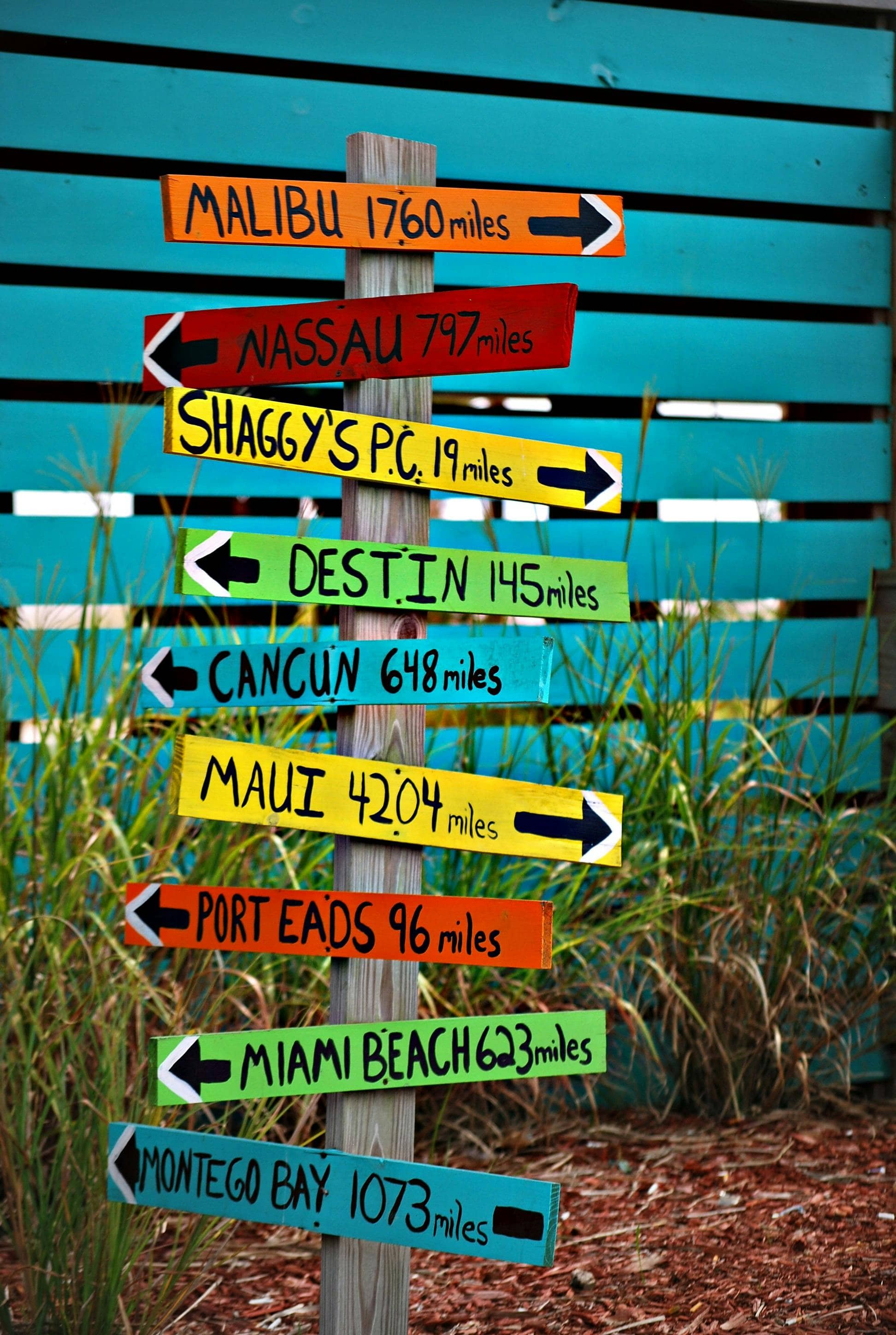
A Travel Agency’s Guide To Destination Management Companies

Travel Agency Software: Everything You Need to Know
Table of contents.
Data Analytics in Tourism Industry: What Is It, Benefits, How It’s Used, & Real-life Examples
What is data analytics in tourism?
Why is data analytics important for the tourism industry, what are the benefits of having data analytics in the tourism industry, how are data science and big data used in tourism industry analytics, real-life examples of data science usage in the tourism industry, how can descriptive analytics help travel agencies.
Big data and data analytics are most commonly tied with industries such as fintech and IT . However, a few years ago, they also made it into the travel sector. They didn’t just make it into the industry. The enormous adoption rates of data analytics in the sector have created a brand new market – the tourism industry and the big data analytics market.
This market’s size reached $220 billion in 2022, and it’s projected to reach $350 billion by 2032 . We are talking about a CAGR of 15% here, which is huge!
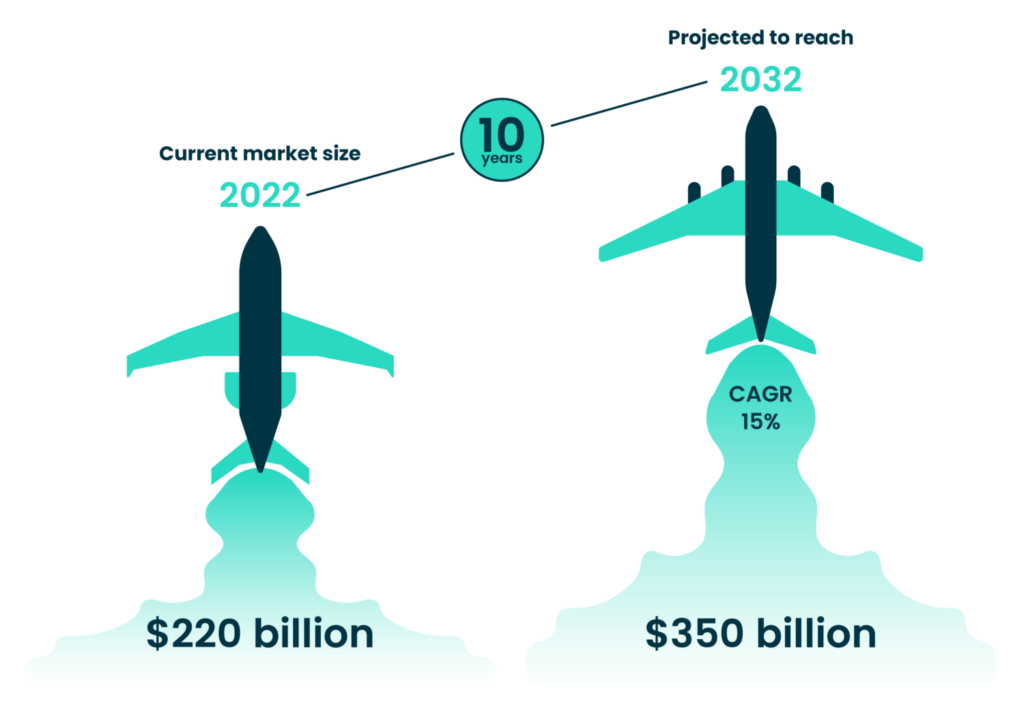
If you are interested in whether big data and data analytics can benefit your business, you need to learn more about these concepts. Below you will find everything you need to assess their value, including real-life examples.
The best way to understand data analytics in tourism is to understand the concept of data analytics.
Data analytics is a domain of data science . It refers to various processes and techniques developed to streamline raw data analysis . Its primary purpose is to help you make sense of data and use it to make informed conclusions and decisions.
Over the years, these processes and techniques have been successfully automated thanks to sophisticated algorithms. The travel sector can now efficiently utilize different types of data analytics.
They can analyze data to see exactly what happened, called descriptive analytics. They can understand why something occurred thanks to diagnostic analytics . Alternatively, they can identify what will happen and what to do next, thanks to predictive and prescriptive analytics.
The data fed to data analytics algorithms is called big data. It only takes a quick literature review to find out the big data definition:
“Big data refers to data sets that are too large or complex to be dealt with by traditional data-processing application software. It enables companies to do at a large scale that cannot be done at a smaller one, to extract new insights or create new forms of value, in ways that change markets, organizations, and more.”
Understanding tourist behavior through data analytics
Building on the previous discussion about what data analysis is, its purposes, and how to comprehend Big Data, we will focus on understanding tourist behavior through data analytics .
We must acknowledge that within an increasingly globalized market, data analytics plays a pivotal role in understanding tourist behavior, thereby enabling the best decision-making for the business.
To further clarify, let’s consider the case of “ The Hotels Network ”.
The Hotels Network is a company founded in 2015 with the goal of increasing direct bookings through hotel websites.
Thanks to the use of data analytics, they realized that there was a gap between the technology offered by hotel websites and that of major travel agencies , in response to customer demand and the need for online booking confirmation.
As a result, the implementation of their technology led to a 32% increase in online bookings through their channel.
Consequently, groups such as Barceló Hotels & Resorts or Petit Palace Hotels have incorporated The Hotels Network into their marketing chain.
The role of data analytics in the tourism and hospitality industry is becoming increasingly important with every passing year. Thanks to new IT technologies, companies in the travel sector can now efficiently track, record, store, and process big data, which enables even small companies to benefit from cutting-edge solutions.
Advances in cloud technologies and infrastructure that support big data and data analytics enabled service providers to decrease costs. It simply means that the travel sector can now use big data in a cost-efficient manner.
Data analytics unlocks many opportunities for travel companies. First and foremost, it allows people who are not data science experts to quickly review large-scale volumes of data . That is important because most of the touch points consumers have with travel businesses are now online, and each one produces some data.
Big data and analytics can finally equip travel companies with everything they need to understand their target customers and capture more profit – or, in other words, gain a competitive advantage.
At the same time, your business also generates internal data. Data analytics is essential because you can truly understand your business processes and how your company interacts with partners and customers.
Many scientific papers are trying to put a finger on the benefits data analytics unlocks for the tourism industry. While there are some subtle differences, all papers find out that big data, data analytics, ML, and AI-enabled strategies help unlock the following benefits.
Thanks to data analytics tools, travel agencies and tour operators can now better understand their markets. They can gauge the market performance to adopt new strategies or refine new ones to achieve more optimal results.
They can better understand their customers and prospects as well. They can identify customer behavior patterns and customize their offer to reflect the current demand to attract more consumers and boost sales.
Data analytics can also help companies put their operations under a microscope. They can analyze the data they generate internally. It can help them achieve operational excellence, reduce operational costs, and make informed customization decisions to facilitate work for their staff.
Data analytics also enables companies to gauge their supply chains. It allows them to source their products in a smarter and more informed manner, thus potentially increasing profit margins while still staying competitive within their markets.
They can ultimately adopt new strategies to generate new revenue streams, maximize profits, and establish a better positioning within a target market.
Data science and big data have found many use cases in the tourism industry analytics. Travel organizations of all sizes are collecting and storing copious amounts of data. Some do it passively as their processes generate data.
For instance, their website can automatically collect data with Google Analytics to facilitate web analytics . They can also store interactions with customers and previous purchase history to personalize service and offer relevant products to consumers.
Others adopt a more active approach, engaging in data-gathering activities such as data mining . It can help them optimize pricing strategies or identify viable marketing channels for specific markets.
The primary role of big data in tourism industry analytics is to enable an accurate decision-making process. Proving accurate, updated, and structured data is paramount in this instance, as the quality analytics outcomes depend on all these factors.
In one study , scientists decided to further examine the impact of the rise of big data and analytics in the travel sector . They found out that most companies that adopt these new technologies do it because access to actionable data enables them to increase sales revenue, improve marketing initiatives, and get a competitive advantage.
One of the recent studies provides a systematic review of the big data use cases in the tourism industry. According to this study, the companies in the sector are using big data to:
- Custom-tailor travel products to meet the needs of market/audience segments;
- Improve cyber-security to enhance the travel experience;
- Create new value by espousing different types of interest;
- Gauge customer sentiment and identify factors of positive and negative engagement on social media.
Understanding data science, data analytics, and big data can be challenging, given that these are all new concepts. The best way to do it is to review some of the use cases. Below you can find real-life examples of data science usage in the tourism industry.
Venice and Salzburg as perfect examples of smart tourism destination
Smart tourism destination is a brand new kind of destination. It refers to destinations that heavily rely on technology to enhance their competitiveness, favor tourism development projects, and improve tourism experiences. These destinations promote the use of technology and capture consumers’ data to fine-tune their offers to deliver delightful experiences to tourists.
The two examples of smart tourism destinations in practice are Venice and Salzburg, as outlined in this study . Using data analytics to model the experience process while visiting Venice and Salzburg helped define destination boundaries and better manage destination stakeholders.
These two destinations managed to improve the co-creation of tourism experiences, be more sustainable and competitive, and promote sustainable tourism and sector development.
Fareboom’s success with the fare predictor tool
Freboom is one of the world’s most popular online travel agencies. They decided that big data and analytics could help them improve their travel booking website by offering attractive prices. To do it, they implemented a fare predictor tool.
The fare predictor tool uses a self-learning algorithm and goes through millions of website fare search records. The algorithm used factors such as demand growth and seasonal trends to predict future price movements, with a confidence rate of 75%. The final results are outstanding as the tool increased the average time a person spends on the Fareboom site by 100% .
Booking.com uses predictive analytics across departments
Booking.com doesn’t require a formal introduction as it’s one of the world’s largest travel marketplaces. When it comes to data analytics, Booking.com might just be a perfect example. Why? Because the company uses it to enable all its departments to make timely and informed decisions.
In one of the recent interviews , Lukas Vermeer, a data scientist at Booking.com, revealed that the company uses data analytics in web marketing, attribution models, ROI predictions, recommendation systems, call volume predictions, and scheduling algorithms.
Mini Cambodian hotel uses big data as a starting point for hotel management
Mini-hotel in Cambodia decided to step up the hotel management strategy by using big data and data analytics. Their goal was to develop a new, more competitive, and cost-effective hotel management strategy. They started using one of the world’s top analytics tools to collect valuable data, including sales statistics, the booker’s country of origin, travel purpose, the device to book, and cancelation details, among others.
The case study reveals that big data and data analytics can be used as a starting point for improving hotel management strategies . In this case, big data enabled the hotel owner to identify new opportunities, find out means to pursue them in the most efficient manner, identify new areas of potential growth, and monitor the effect of the new strategy.
Hyatt’s intelligent virtual assistant and data analytics save the company $4.4 million
Hyatt is one of the largest hospitality companies out there. It handles hundreds of thousands of calls per month. Since it became borderline impossible to provide a great customer experience using only human assistants and agents, the company decided to deploy an intelligent virtual assistant.
The virtual assistant’s role was to automate the new reservation process, transfer callers, and automate, confirm, and cancel reservations. More importantly, it could collect data and feed it to the data analytics engine. Thanks to automation and data analytics, Hyatt reduced contact center costs by 33% and saved 94% on fully automated interactions which roughly translates into $4.4 million.
Qantas airline significantly reduced the number and length of delays thanks to data analytics
As one of the world’s most reputable airlines, Qantas wanted to improve its schedule recovery to provide nothing but the best transportation experience to consumers. To do it, the company decided to make use of data. They invested in a schedule recovery solution that uses real-time data analytics to provide instant insights.
The results were outstanding. Qantas was able to assess all aspects of the operational costs, reduce the number and length of delays, and significantly reduce the cost of managing flight disruptions , whether due to weather conditions, excessive traffic, or unforeseen operational delays.
As we’ve previously stated, descriptive analytics provides answers to the “What happened” question. It can include various historical data types, but it can also be applied to data streams in real-time. With this in mind, descriptive analytics can help travel agencies in many ways:
- Better understand customers – a travel agency can track numerous behavioral metrics to truly understand customers and their preferences. Thanks to these insights, you can easily personalize your offer in a cost-efficient manner;
- Improve brand image – descriptive analytics can help travel agencies manage their brand reputation. They can mine data from social media platforms to gauge customer sentiment, respond to
- Dynamic pricing management – imagine being able to adjust prices in real-time based on the supply, demand, and competitors’ prices. That’s precisely what descriptive analytics can offer to travel agencies of all sizes;
- Smart route optimization – cross-referencing logistics with customer behavioral data can help travel agencies further delight customers and make traveling more convenient. Smart route optimization refers to identifying and offering the most optimal flight and travel routes to customers;
- Make travel safer for everyone – fintech companies are already using descriptive analytics to detect frauds and anomalies in their transaction data sets. Travel companies can do it too to offer additional protection to their customers. With predictive analytics, they can easily detect unauthorized payments and stolen accounts.
Data analytics has found many applications in the travel sector. It can offer actionable insights and streamline the decision-making process, and many organizations are already using solutions with built-in data analytics capabilities.
They have various goals ranging from improving customers’ experience to maximizing profits. Given that the tourism industry and big data analytics market are projected to continue to grow, the chances are that we are going to see even more use cases of data analytics in the sector .
Subscribe to our newsletter
Yay you are now subscribed to our newsletter.

Marc Truyols has a degree in Tourism from the University of the Balearic Islands. Marc has extensive experience in the leisure, travel and tourism industry. His skills in negotiation, hotel management, customer service, sales and hotel management make him a strong business development professional in the travel industry.
Mize is the leading hotel booking optimization solution in the world. With over 170 partners using our fintech products, Mize creates new extra profit for the hotel booking industry using its fully automated proprietary technology and has generated hundreds of millions of dollars in revenue across its suite of products for its partners. Mize was founded in 2016 with its headquarters in Tel Aviv and offices worldwide.
Related Posts
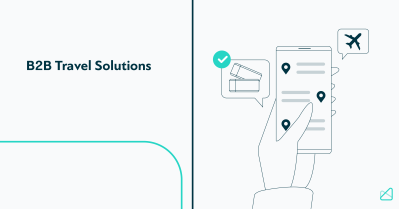
Your Ultimate Guide to B2B Travel Solutions
17 min. You’ve probably noticed that B2B travel solutions play a vital role in the global B2B travel sector. We are talking about the market bound to reach the size of $4952.96 by 2028. That’s a CAGR Growth of 17.51%. No wonder leading B2B travel solutions process over 80.000 bookings and 14.000 searches a day. […]
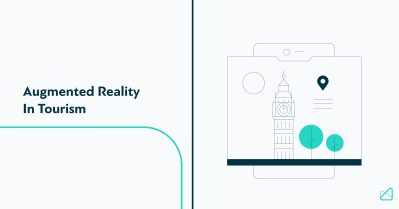
5 Ways Augmented Reality is Enhancing the Tourism Experience
20 min. Augmented reality (AR) can truly transform the way people discover and explore new places. By combining physical exploration with digital elements, travelers are able to gain deeper insights into different cultures while making memories along the way. In today’s world, more and more travelers are turning to technology to add excitement and convenience […]

Everything You Need to Know About Virtual Tourism Companies
24 min. Virtual tourism refers to a specific tourism niche using technology that enables travelers to experience activities, locations, and destinations without leaving their homes. The types of virtual tours depend on the multimedia format offered to travelers. It can be anything ranging from still images, video, and audio to interactive virtual reality. The popularity […]

The Importance of Business Travel Data Analytics
Travel managers typically have all the data needed for strong travel analytics. they just need a plan for getting started..
Of all corporate activity, business travel should yield the most insightful data — which means that travel analytics represent a huge opportunity. That said, most businesses today are only beginning to tap into the potential of travel analytics.
The data needed for insightful travel analytics is almost always available. It just needs to be accessed and organized in a meaningful way. As a Travel Manager, accessing the right data and properly organizing it will allow you to quickly report to executives and to make the case for additional travel-related investments.
Here’s a simple 3-step process you can use to leverage data and travel analytics.
1. identify goals and objectives.
It’s always helpful to start with the end in mind. As you look at data and think about travel analytics that would be helpful, consider you and your company’s travel-related goals and objectives. Are you interested in:
- Improving traveler safety?
- Reducing expense fraud?
- Negotiating better supplier contracts?
- Meeting corporate social responsibility goals?
- Something else entirely?
No matter what they are, let your goals and objectives drive your travel analytics strategy. It’s often helpful to think in terms of a dashboard. If you could create a travel analytics dashboard, what insights would you want it to provide at a glance? With the right dashboard, you’ll be able to measure ongoing performance and successfulness as you push toward goals.
2. Crunch Your Own Numbers
At some point, you’ll likely choose a platform such as Prime Numbers or Grasp to help you with travel analytics. But, well before you choose and establish a platform, try crunching the numbers that are already available.
You are likely surrounded by travel data that is just waiting for analysis. Choose one of your goals or objectives, and see what data you can find related to it. Getting started on your own helps you do 3 things.
First, it’s good to show key stakeholders what information exists and the power that it holds. Second, an early data analysis can help you identify gaps in your information and where you need to start capturing additional data. And, finally, an early data analysis will help you understand the time commitment that travel analytics requires.
It’s good to show key stakeholders what information exists and the power that it holds. An early data analysis can help you identify gaps in your information and where you need to start capturing additional data.
3. Enjoy Potential Savings
Once you’ve established goals and objectives, and once you’ve crunched some initial numbers, you should develop an idea of where your company is missing opportunities.
Finding potential savings does two things. First, you’re able to benchmark your travel spend against competitors. And, second, the potential for savings is a great way to make a business case to key executives.
So use the first two steps above to find potential savings, create a plan to quickly realize them, and then share that plan with corporate leadership. Most companies can save up to 20% by pinpointing potential savings and making the adjustments needed to realize them.
How Better Travel Analytics and Data Pay Off
There are myriad ways this 3-step process can pay off in the long run. But what kinds of real outcomes can you expect from building a data and travel analytics plan? Here’s a look at 3 ways that quality travel analytics can pay big dividends:
- Overspending: Travel analytics could help your company identify specific travelers who regularly overspend.
- Total Trip Cost: Travel analytics can pull data from multiple sources, making it possible to create a total trip cost for comparison against compliance and creation of a trip’s ROI.
- Real-Time Tracking: We all have budgets. Travel analytics can help you create a snapshot comparison of spend vs. budget that you can access whenever needed.
Support to Help You Get Started
Travel analytics can be incredibly helpful — but they can also be difficult to generate. At JTB Business Travel, we often help our clients identify the right travel technologies so that they can analyze travel spend and other key metrics. If you need support getting started with travel analytics, we’re here to help.
Contact us today and learn more about our services as a comprehensive business travel agency.
Related Post

How AI Tools are Turning Your Daily Tasks into Streamlined Processes
As a Travel Arranger, there are likely many tedious tasks you need to complete as part of your role. Could AI tools help take over some of the minutiae of your workday? The jury’s still Read more

NDC Content: What to Expect from JTB Business Travel
NDC has been in the works for more than a decade. However, it’s still a somewhat foreign concept to many who book travel for work. JTB Business Travel is channeling NDC content to make Travel Read more

Our Thriving Network of Global Partners Gets Better With Spotnana’s Booking Platform
These two like-minded companies are joining forces to ensure access to a next-generation booking platform plus world-class customer service for small- and medium-sized enterprises. A new partnership announced earlier this month between JTB Business Travel Read more

Sustainability-Focused Airlines: How to Choose, Support and Fly Them
A lot of airlines purport to be “sustainable,” but are some airlines more sustainable than others? A look at the world’s most sustainability-focused airlines says yes. In some regions of the world, sustainability is a Read more

Travel by Train vs. Plane for Short Trips
When it comes to choosing travel by train vs plane, there’s a lot to consider: speed, convenience, price—and, of course, sustainability. Depending on where you live in the world, your first instinct might be to Read more
Insightful post for frequent business traveler. Glad you shared
Leave a Comment
Add to the conversation or ask a question: cancel reply.
This site uses Akismet to reduce spam. Learn how your comment data is processed .
Post Categories
- For Executives
- For Travel Managers
- For Travelers
- Press Release
Recent Posts

Sustainable Leadership in Business Travel: Top Examples in Aviation

Meet Yiannis Ioannou: An Industry Veteran Embracing New Beginnings

Stay Up To Date!
The Choice Is Yours - Get the exact Business Travel information you want delivered directly to your inbox.
TravelConcierge News
TravelConcierge News (Japanese)
- Travel Risk Alerts
Waypoint Monthly News
JTB Event Updates
The latest from JTB Business Travel
- How AI Tools are Turning Your Daily Tasks into Streamlined Processes As a Travel Arranger, there are likely many tedious tasks you need to complete as part of your role. Could AI tools help take over some of the minutiae of your workday? The jury’s still out on whether or not AI will (or even should) take over creative tasks like writing the next great novelRead […]
- Sustainable Leadership in Business Travel: Top Examples in Aviation As World Environment Day, June 5, approaches, it’s worth recognizing sustainable leadership throughout the business travel industry. Which top players are setting new standards, and which might inspire you to set new standards of your own? It’s no secret. The aviation sector is responsible for a large amount of the carbon emissions that result fromRead […]
- Meet Yiannis Ioannou: An Industry Veteran Embracing New Beginnings From his home in Cyprus, Yiannis embraces a motto of “Good food, good wine, good company!” Yiannis Ioannou has just passed a career milestone: one year as a JTB Business Travel Advisor. Yiannis is hardly new to the industry, though; he brings a wealth of experience to the role with more than 30 years ofRead […]
- NDC Content: What to Expect from JTB Business Travel NDC has been in the works for more than a decade. However, it’s still a somewhat foreign concept to many who book travel for work. JTB Business Travel is channeling NDC content to make Travel Arrangers’ and Travelers’ experiences better. New Distribution Capability (NDC) has been touted as a new solution that will offer moreRead […]
- Our Thriving Network of Global Partners Gets Better With Spotnana’s Booking Platform These two like-minded companies are joining forces to ensure access to a next-generation booking platform plus world-class customer service for small- and medium-sized enterprises. A new partnership announced earlier this month between JTB Business Travel and Spotnana blends the benefits of exceptional travel service and world-class Travel-as-a-Service technology to the benefit of small- and medium-sizedRead […]
- Sustainability-Focused Airlines: How to Choose, Support and Fly Them A lot of airlines purport to be “sustainable,” but are some airlines more sustainable than others? A look at the world’s most sustainability-focused airlines says yes. In some regions of the world, sustainability is a big deal. Governments have taken significant measures to place parameters around what private companies can do. They’ve set standards forRead […]
- The Importance of Ethical Sourcing in Travel Thinking about how your organization travels? A lot of sustainability buzzwords will arise: carbon accounting, ESG and, now, ethical sourcing. What does it mean, and why does it matter? Ethical sourcing is just one of the phrases you’ll hear bandied about as you first begin approaching your company’s sustainable business travel. What it means toRead […]
- JTB Business Travel Partners with Spotnana to Modernize Business Travel Management This pairing of exceptional service and industry-leading technology will benefit small to medium enterprises as they pursue seamless, cost-efficient, and sustainable travel. Torrance, CA, May 1, 2024 – JTB Business Travel, a JTB USA, Inc. brand and leader in providing tailored travel management to small and midsize enterprises, announces its global strategic partnership with Spotnana,Read […]
SAP Concur Partner | TMC Elite
Privacy Statement
GDPR and Privacy Statement Europe
GDPR Privacy Statement
CCPA Privacy Policy
Copyright 2022 JTB Business Travel. All Rights Reserved. CST#2031531-50
Site by Ruff Haus
JTB Business Travel Services:
• Home
• For Travelers
• For Travel Managers
• For Executives
• Contact Us
Stay Connected:
- Trip Disruption Assistance
- Travel Ready, Travel Safe
- Book Travel Anytime
- Before Your Trip
- During Your Trip
- After Your Trip
- Business Intelligence
- Duty of Care
- Traveler Care
- Account Management Services
- Cost Saving Programs
- Full Content
- Travel Technologies
- Cost Avoidance
- Virtual Payments
- Risk Mitigation
- Travel Management 2.0
- Our Expertise
- Spend Management
- Corporate Meetings & Events
- JTB AnswerCenter
- Business Travel InSight
- Traveler Training
- Video Library
- Waypoint Blog
- Go Like a Pro with National
- eSIM Phone Services
- eVisa Assistance
- Global Entry Locations
- Print My Invoice
- Travel Requirements Help
- Travel Reports
- Traveler WorldCue
- TSA PreCheck Map
- JTB Business Travel
- JTB Business Travel Brand Resources
Data Analytics in Travel Industry: Stand Out in the Crowd
Data Analytics brings endless opportunities for the travel industry. A large amount of valuable data is generated at every stage of a trip and with a lot of people traveling around the globe, this data can offer significant insights. Travelers buy stuff online, create an itinerary, save dates on calendars, use GPS to reach their destination and so on. At every stage of their trip, they leave a data trail. The experts now analyze this data and infer various insights to enhance the customer traveling experience.
However, collecting this data and connecting it is a bit of a challenging task for data analysts, but the discernments obtained can revolutionize the travel industry and make this venture a more profitable business than it was ever before. There are several ways in which data analytics services are currently assisting the travel industry to do better and meet its goals.
Business Data Analytics in Travel Industry
Machine Learning and Artificial Intelligence are picking up traction in the travel industry to help airlines and hotels make data-driven decisions based on accurate and actionable insights. Business analytics provide real-time insights about customers using data from multiple sources. Data like flight bookings, hotel stays, schedule patterns, repeat bookings, flight preferences, and so on is collected from websites, apps, social media, customer accounts, etc., and stored in a centralized database. This data is cleaned and processed to avoid redundancy.
Analytical tools are used to analyze this data in real-time and share insights with the business to help make strategic decisions. Business analytics in the travel industry help airlines and hotels understand customer behavior and market trends. When the airline knows what a customer expects or wants, it can customize the services to enhance customer experience and thus inspire brand loyalty.
Business analytics helps in the data-driven transformation of the travel industry. The pandemic has pushed the travel industry into losses and havoc. Business analytics is a way to bring the necessary change and empower the airlines to recover from the dire situation and come out stronger.
Experts claim that the use of predictive and prescriptive analytics will be a game-changer in the industry . Data science and predictive modeling can help airlines uncover critical intelligence to provide real-time actionable insights that help in recovering and gearing up to make the most of new market opportunities.
An important aspect to consider is automation. Even though many businesses are already using data analytics, they spend too much time, energy, and money on cleaning the data rather than running analytics and using the insights. Artificial intelligence and machine learning make automation possible by streamlining data collection, cleaning, and storage processes. This gives airlines more time to run queries and use the insights without delay.
Designing an Effective Business Strategy
To build an effective business strategy it is important for an organization to be aware of its customer base and its preference. With the help of data analytics and predictive analytics tools, the data collected in the form of feedback, customer reviews, social media posts, etc. is utilized to infer the behavior pattern of the customers. This, thus, causes the organizations to comprehend their customer’s needs and offer services that will bring them more benefits. The bits of knowledge are utilized by the firm to tailor customized plans for its clients. Better services offered by the firm not only help to retain loyal customers but also boost sales and improve reputation.
Let’s You Stand Out in the Crowd
When a traveling firm uses data analytics services to distinguish itself from its competitors, it is able to create lucrative offers that cater to the needs of the clients and at the same time help you to gain an edge over others.
For instance, Amadeus (a Global Distribution System) allows its users to ask simple travel-related questions without entering any personal details. The questions can be as basic as – When will I get the cheapest flight to Italy? Or is it possible to travel somewhere for just 700 $?
These types of services make it very convenient for users to clear their travel-related doubts and get reliable advice. Once a customer starts to trust the product, he/she will definitely return to use it and in the process become a loyal customer. However, retaining customers is another challenge that must be carefully dealt.
Improve the Pricing Strategy
While planning travel, money is one of the major concerns. People spend hours and days finding that one tour package that can offer them the best deals without cutting a hole in their pocket. But how would the firms know beforehand what the customer wants from them?
The simple answer could be data analytics. All searches made by the visitors’ on a firm’s website can be used to infer the budget that a major chunk of people can afford to travel. Keeping this in mind a well-tailored travel plan can be devised and placed on the website. This is the strength of applying data analytics, you can predict what will happen next. For instance, firms like KAYAK have been using data analytics to forecast the changes in flight prices for the coming seven days.
Taking Better Decisions
Taking upright decisions is one of the key aspects of improving a business. With the help of data analytics, travel planners are able to draw better choices based on real predictions and not just intuitions. Data analytics allows the firms to develop customers’ profiles and thereby helping them to accurately target the market campaigns.
As per Forrester, data analytics tends to increase customer responsiveness up to 36%. Being able to comprehend the demand of the customer and recent ongoing trends in the market lets the companies peep into the future and perform accordingly. The famous Nippon Airways uses data analytics to optimize its cargo management system thus making it one of the largest airlines in Japan.
Making the Tough Easy
Having data analytics at your disposal prevents painful losses and enhances revenue for the travel industry. To understand this, consider a situation where there is a group of people who have their bookings to fly from the USA to London the next day, but due to some reasons the flight got canceled and all their bookings will be wasted.
In this case, the group is ought to give negative feedback to the airlines for not giving them a prior notification or for being dissatisfied with their services. In such a scenario, you may use the power of data analytics to warn them of flight cancellations or help them choose a travel plan that is more certain.
The Final Words
People will always look forward to going on a vacation and spending quality time with their friends or family and therefore travel will never go out of trend. So if you are the owner of a travel agency or are related to the business in any form, the opportunities for you to help your traveler achieve the absolute holiday are endless. Incorporating data analytics into the business will offer you insights that will empower your growth.
Expert groups, like DataToBiz , can help you analyze the customer data and let you know where you need to add value so as to come up with a never-like-before experience for your client. If there is a problem, they can find a way to resolve it, just by drawing efficient evidence all data could bring out, analytics tools and expert methods being their path. The professionals here hold expertise in the field of machine learning, data analytics, predictive analytics, and artificial intelligence.
If you are looking for specialists that can assist you in implementing data science into your business, contact us
Kavika is Head of Information Management at DataToBiz. She is responsible for identification, acquisition, distribution & organization of technical oversight.
Amazing blog.
I am from this industry and I feel that this is implementable.
Leave a Reply Cancel reply
You must be logged in to post a comment.
Data Engineering
AI & Machine Learning
By Use Cases
Business Intelligence & Tableau
+91 70099 35623
[email protected], f-429, industrial area, phase 8b, mohali, pb 160059 punjab, india, ©2024 datatobiz r all rights reserved.
- Privacy Policy
DataToBiz is a Data Science, AI, and BI Consulting Firm that helps Startups, SMBs and Enterprises achieve their future vision of sustainable growth.
- ©2024 DataToBiz Ⓡ All Rights Reserved
Subscribe To Our Newsletter
Get amazing insights and updates on the latest trends in AI, BI and Data Science technologies
Travel Data + Analytics
Current booking situation + your product performance + market opportunities
TDA in the travel industry
Latest news.
Future-Oriented Business Models for Tour Operators: Navigating Through Market Changes in the Context of Price and Demand Shifts
Roland Gassner / Director Business Development Travel Data + Analytics To the event
INTERGASTRA
Germany in EM anticipation - will 2024 bring a new summer fairytale for domestic tourism?
Podcast: Will 2024 be a good year for travel?
Dr. Markus Heller / CEO Travel Data + Analytics Read Article
Knowing more is half the battle
Our mission.
The successful business development of your company is our mission. We assist tourism enterprises in better understanding their own performance in the context of the industry and against the background of current market developments, and in optimally exploiting potential. Numerous businesses and organizations in the travel industry rely on the independent analyses of Travel Data + Analytics, as it is the only instrument depicting the German travel market in a market-representative manner on the basis of real booking data and professional projection methods with highest data quality.
Precise Facts – Profound Insights – Valuable Knowledge

Winter season 2023/24 ends with strong growth
Nuremberg, May 31, 2024 – As already expected by booking activities of the last months, the 2023/24 winter season, which ended with the booking month of April 2024, ended with double-digit sales growth compared to both the previous year and the pre-corona level. Following ...

Turkey & Spain almost on a par for summer holidays
Nuremberg, April 30, 2024 – Germans are in the mood to travel. Many have booked their holiday trips early again this year. The volume of bookings remains at a good level compared to the previous year, although the previous year ...

Growth of Winter Season is obvious
Nuremberg, March 28, 2024 – The volume of new bookings in the German holiday market for tour operator holidays remains at a high level, exceeding that of the previous year. Overall, sales generated in travel sales in the booking month of February 2024 ...
Become a data partner now and get profound market insights
- Deutschland
- Asia, Australia & New Zealand
- Europe, Middle East & Africa
- United States & Canada
- Latinoamérica
Travel insights: How people plan a trip from beginning to end
When it comes to travel, the path to purchase is full of twists and turns. These travel insights help illuminate the why and how behind trip bookings.
Share this page
There is a range of reasons why people across the globe are inspired to book trips..
17% of people surveyed say they were inspired to book a trip simply because they regularly think about trips they want to take .
Travel Insights Data 01
16% of people surveyed say they were inspired to book a trip because they had wanted to travel to a destination for some time .
Travel Insights Data 02
16% of people surveyed booked a trip because they felt they were due a vacation .
Travel Insights Data 03
8% of people surveyed were inspired to travel because they wanted to visit a friend or family member .
Travel Insights Data 04
7% of people surveyed booked a trip to travel and celebrate a special event .
Travel Insights Data 05
7% of people surveyed booked a trip because they saw a special offer or discounted price for travel to a destination.
Travel Insights Data 06
To convert inspiration to bookings, businesses need to ensure they meet travelers' needs..
The average traveler spends 13% of their time online conducting travel-related activities.
Travel Insights Data 07
of people surveyed say they didn’t make a booking online when they intended to because it didn’t meet their needs .
Travel Insights Data 08
of people surveyed say they didn’t make a booking online when they intended to because the price was too high .
Travel Insights Data 09
Even after completing a booking, many travelers continue to research and find inspiration..
of people surveyed keep visiting travel-related sites after booking.
Travel Insights Data 10
of people surveyed re-research a trip after completing a booking.
Travel Insights Data 11
of travelers surveyed cancel and re-book their trip after completing a booking.
Travel Insights Data 12
UN Tourism | Bringing the world closer
The first global dashboard for tourism insights.
- UN Tourism Tourism Dashboard
- Language Services
- Publications
share this content
- Share this article on facebook
- Share this article on twitter
- Share this article on linkedin
UN Tourism Data Dashboard
The UN Tourism Data Dashboard – provides statistics and insights on key indicators for inbound and outbound tourism at the global, regional and national levels. Data covers tourist arrivals, tourism share of exports and contribution to GDP, source markets, seasonality and accommodation (data on number of rooms, guest and nights)
Two special modules present data on the impact of COVID 19 on tourism as well as a Policy Tracker on Measures to Support Tourism
The UN Tourism/IATA Destination Tracker
UN Tourism Recovery Tracker
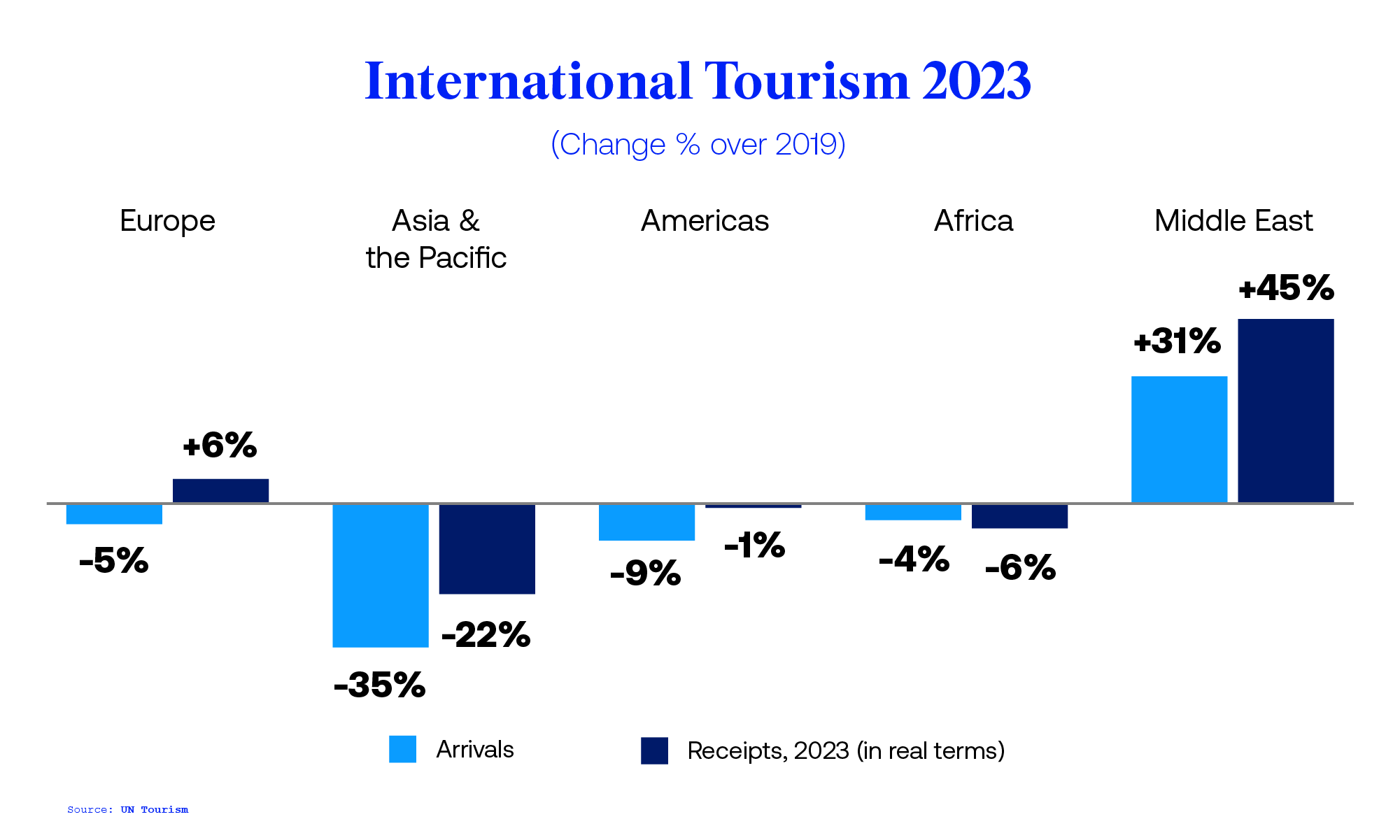
- International tourist arrivals and receipts and export revenues
- International tourism expenditure and departures
- Seasonality
- Tourism Flows
- Accommodation
- Tourism GDP and Employment
- Domestic Tourism
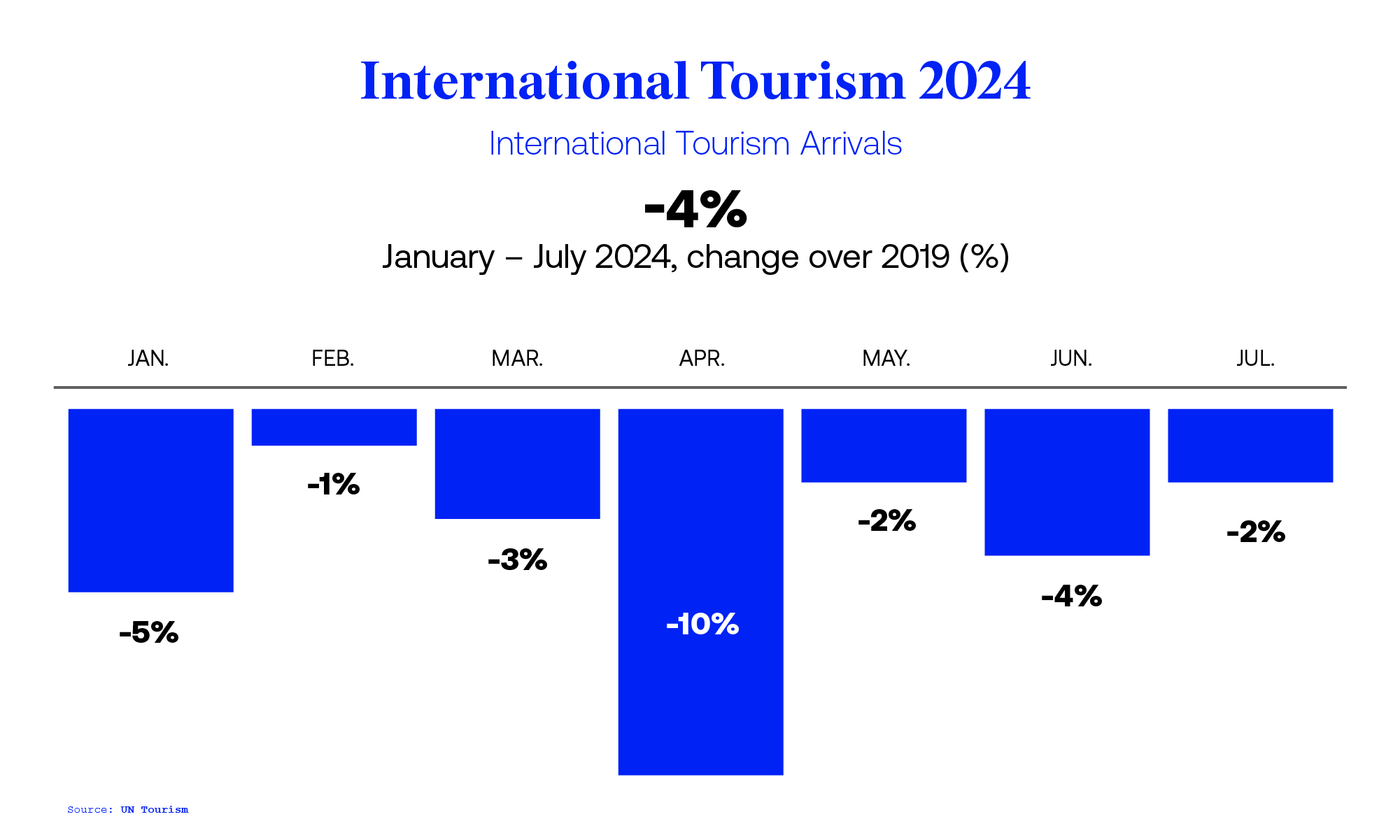
International Tourism and COVID-19
- The pandemic generated a loss of 2.6 billion international arrivals in 2020, 2021 and 2022 combined
- Export revenues from international tourism dropped 62% in 2020 and 59% in 2021, versus 2019 (real terms) and then rebounded in 2022, remaining 34% below pre-pandemic levels.
- The total loss in export revenues from tourism amounts to USD 2.6 trillion for that three-year period.
- International tourist arrivals reached 89% of pre-pandemic levels in 2023 and 97% in Q1 2024
COVID-19: Measures to Support Travel and Tourism
An official website of the United States government
- Special Topics
Travel and Tourism
Travel and tourism satellite account for 2018-2022.
The travel and tourism industry—as measured by the real output of goods and services sold directly to visitors—increased 21.0 percent in 2022 after increasing 53.6 percent in 2021, according to the most recent statistics from BEA’s Travel and Tourism Satellite Account.
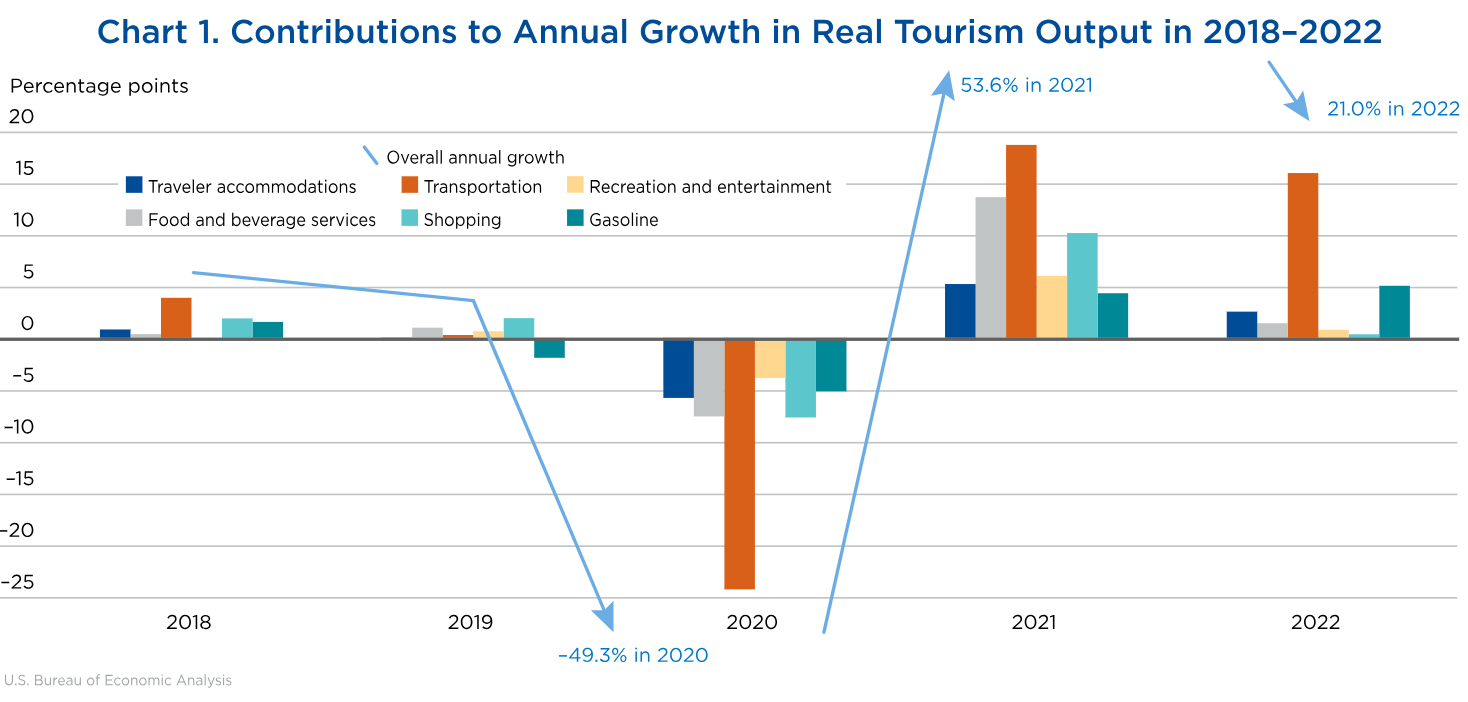
Data & Articles
- U.S. Travel and Tourism Satellite Account for 2018–2022 By Hunter Arcand and Paul Kern - Survey of Current Business April 2024
- "U.S. Travel and Tourism Satellite Account for 2015–2019" By Sarah Osborne - Survey of Current Business December 2020
- "U.S. Travel and Tourism Satellite Account for 2015-2017" By Sarah Osborne and Seth Markowitz - Survey of Current Business June 2018
- Tourism Satellite Accounts 1998-2019
- Tourism Satellite Accounts Data A complete set of detailed annual statistics for 2017-2021 is coming soon -->
- Article Collection
Documentation
- Product Guide
Previously Published Estimates
- Data Archive This page provides access to an archive of estimates previously published by the Bureau of Economic Analysis. Please note that this archive is provided for research only. The estimates contained in this archive include revisions to prior estimates and may not reflect the most recent revision for a particular period.
- News Release Archive
What is Travel and Tourism?
Measures how much tourists spend and the prices they pay for lodging, airfare, souvenirs, and other travel-related items. These statistics also provide a snapshot of employment in the travel and tourism industries.
What’s a Satellite Account?

- TTSA Sarah Osborne (301) 278-9459
- News Media Connie O'Connell (301) 278-9003 [email protected]
- Today's news
- Reviews and deals
- Climate change
- 2024 election
- Fall allergies
- Health news
- Mental health
- Sexual health
- Family health
- So mini ways
- Unapologetically
- Buying guides
Entertainment
- How to Watch
- My Portfolio
- Latest News
- Stock Market
- Biden Economy
- Stocks: Most Actives
- Stocks: Gainers
- Stocks: Losers
- Trending Tickers
- World Indices
- US Treasury Bonds
- Top Mutual Funds
- Highest Open Interest
- Highest Implied Volatility
- Stock Comparison
- Advanced Charts
- Currency Converter
- Basic Materials
- Communication Services
- Consumer Cyclical
- Consumer Defensive
- Financial Services
- Industrials
- Real Estate
- Mutual Funds
- Credit Cards
- Balance Transfer Cards
- Cash-back Cards
- Rewards Cards
- Travel Cards
- Student Loans
- Personal Loans
- Car Insurance
- Mortgage Calculator
- Morning Brief
- Market Domination
- Market Domination Overtime
- Asking for a Trend
- Opening Bid
- Stocks in Translation
- Lead This Way
- Good Buy or Goodbye?
- Fantasy football
- Pro Pick 'Em
- College Pick 'Em
- Fantasy baseball
- Fantasy hockey
- Fantasy basketball
- Download the app
- Daily fantasy
- Scores and schedules
- GameChannel
- World Baseball Classic
- Premier League
- CONCACAF League
- Champions League
- Motorsports
- Horse racing
- Newsletters
New on Yahoo
- Privacy Dashboard
Yahoo Finance
Travel apps industry report 2024: how travel and tourism companies are utilizing travel apps to drive revenues.
Dublin, June 04, 2024 (GLOBE NEWSWIRE) -- The "Thematic Intelligence: Travel Apps (2024)" report has been added to ResearchAndMarkets.com's offering. This report provides an overview of the impact travel apps has on the travel sector and seeks to understand some of the contributory factors. The key trends within this theme are split into three categories: consumer trends, enterprise trends, and industry trends. Several case studies are included to analyze the multiple ways countries and companies have responded to the impact of travel app's growth and what they are doing to grow with this market. The report analyzes the players impacted by this theme alongside the contributing trends, destination trends, unintended opportunities, and trends that have emerged as a result of travel apps. It then dives deep into an industry analysis, presenting several real-life case studies looking at how companies have responded to the impact of this theme on their operations. Recommendations are also offered for the travel sector, alongside a description of companies mentioned throughout. This report focus is on travel apps. Key Highlights
Globally, travelers are increasingly online and more mobile savvy than ever before. The online travel market value is expected to increase going forward, according to the analyst forecasts. By 2026, market value is projected to reach $662.63 billion (CAGR 2023-26: 7.98%) as travelers increasingly switch to online travel intermediaries over in-store travel agents.
According to the analyst's Q4 2023 Consumer Survey, 80% of global respondents stated that 'time saving' is either 'essential' or 'nice to have' when making a purchase and 83% of global respondents stated that 'convenience' is either 'essential' or 'nice to have' when making a purchasing choice.
Travel apps allow companies to offer a more convenient service, which often saves both time and money for consumers. When looking specifically at OTAs (online travel agencies), the most successful companies in this sub-sector give little reason for customers to shop elsewhere when purchasing the main services and products that create a domestic or international trip.
The number of consumers who access the internet via mobile devices is increasing across the globe. When assessing the increase in the number of mobile internet subscribers across G7 nations (an organization of the world's seven largest so called 'advanced' economies, and therefore important tourism source markets), all countries displayed healthy growth.
Key Report Features
Understand the current travel apps trends within the travel landscape today and how these will escalate in the near future.
Assess how travel and tourism companies such as tour operators, OTAs and DMOs are utilizing travel apps to drive revenues.
Acknowledge the potential pitfalls of using travel by understanding the social, cultural, and environmental effects on the destination.
Discover recommendations for businesses involved in travel apps.
The analyst's thematic research ecosystem is a single, integrated global research platform that provides an easy-to-use framework for tracking all themes across all companies in all sectors. It has a proven track record of identifying the important themes early, enabling companies to make the right investments ahead of the competition, and secure that all-important competitive advantage. All across the travel and tourism supply chain, now have an opportunity to capitalize on travel apps, and there are notable examples of this. Therefore, all should buy this report to fully understand how this theme will continue to be a key theme in the future travel landscape.
Company Coverage:
IHG Hotels & Resorts
Marriott Hotels & Resorts
Key Topics Covered:
Executive Summary
Thematic Briefing
Technology trends
Consumer trends
Industry trends
Industry Analysis:
Market size and growth forecasts
M&A trends
Venture financing trends
Patent trends
Company filing trends
Social media trends
Value Chain:
Intermediaries
Transportation
Destination
Travel services
Public companies
Private companies
Sector Scorecards:
Travel intermediaries sector scorecard
Rail and road sector scorecard
For more information about this report visit https://www.researchandmarkets.com/r/eu57gq
About ResearchAndMarkets.com ResearchAndMarkets.com is the world's leading source for international market research reports and market data. We provide you with the latest data on international and regional markets, key industries, the top companies, new products and the latest trends.
For the best Oliver Wyman website experience, please upgrade your browser to IE9 or later

- Global (English)
- India (English)
- Middle East (English)
- South Africa (English)
- Brazil (Português)
- China (中文版)
- Japan (日本語)
- Southeast Asia (English)
- Belgium (English)
- France (Français)
- Germany (Deutsch)
- Italy (Italiano)
- Netherlands (English)
- Nordics (English)
- Portugal (Português)
- Spain (Español)
- Switzerland (Deutsch)
- UK And Ireland (English)
Over the past year, generative artificial intelligence (AI) has quickly established its presence in the leisure travel industry . The technology is revolutionizing how consumers get their best ideas for vacations and then plan those trips, while democratizing access to comprehensive travel advice and bargains.
As capabilities expand, more consumers are discovering the tools and using them for more than just finding a convenient flight or comfortable hotel. The generative AI enthusiasts are increasingly relying on the technology to help them plan entire itineraries. This can include anything from swimming with dolphins in the Caribbean to figuring out which restaurants they need to reserve for their trip to Copenhagen.
Growing enthusiasm for generative AI in travel planning
Findings from our surveys of North American leisure travelers highlight the growing fervor for using generative AI applications to make trip planning easier: 41% of the nearly 2,100 consumers from the United States and Canada told our March 2024 survey that they had recently used generative AI tools for travel inspiration or itinerary planning. That is up from 34% of respondents in our August 2023 survey.
Looking ahead, 58% of respondents and 82% of recent generative AI users said they are likely or very likely to use the technology for inspiration or itinerary planning again in the future. This indicates high levels of consumer satisfaction with generative AI tools, and the market should be confident and optimistic about prospects for growth going forward.
Five takeaways from our analysis and leisure traveler survey results
- Leisure travelers are increasingly using generative AI tools for trip inspiration and itinerary planning.
- The most enthusiastic adopters tend to be younger, elite loyalty members, and people who like to take cruises .
- Generative AI has the capabilities to address existing trip inspiration and travel planning pain points for consumers, and users are recognizing that.
- When choosing a generative AI tool, consumers have more confidence in those being offered by brands they frequently use or with which they have a loyalty program membership. The connection between brand loyalty and generative AI is likely to drive more direct bookings and ancillary revenue for brands that develop robust generative AI tools.
- Generative AI makes it more likely that consumers will book a complete trip based on recommendations from the tool, increasing the average trip value for brands through sales of ancillary services and products and packaged travel offerings. That prospect should grow dramatically once travelers can book directly through generative AI tools.
Opportunities and risks for travel companies adopting generative AI
From the perspective of travel companies, there is significant opportunity and white space in the market to capitalize on growing consumer willingness to use generative AI. Those that act quickly to develop booking and personalization capabilities that meet the expectations of their loyal customers will benefit at the expense of those in the sector that drag their feet.
Our findings indicate that generative AI can be a mechanism for travel companies to connect with customers earlier in the planning process and use that engagement to show them what else they might consider. This should strengthen brand loyalty, improve conversions, and drive more direct bookings once that capability is available.
But there are also risks from not being proactive. From an economic standpoint, our analysis revealed that more than $2 billion of commissions to online travel agencies could be at play in a scenario where suppliers largely continue to forgo investment in generative AI.
And the clock is ticking, considering the speed at which new technologies are adopted today. In other words, the time to embrace the technology is now, and the companies that do that effectively will be well-positioned to dominate leisure travel going forward.

- Data and Artificial Intelligence
- Harnessing Risk
- Industry Transformation
- Transportation and Services
- Travel and Leisure
- Scot Hornick,
- Julien Boulenger,
- Grant Alport, and
- Lawrence Burka
Additional contributors: Frank DePinto and Andrea Yamhure Sepulveda.
Generative AI’s Influence on Leisure Traveler Behaviors
Leisure travelers are embracing generative AI for trip planning, which is creating opportunities and challenges for the travel industry.
Generative AI Has Intrigued The Most Dedicated Travelers
Elite loyalty members embrace generative AI travel tools, offering suppliers a chance to enhance customer satisfaction and drive economic value.
Generative AI’s Revolution Of The Cruise Industry
Generative AI tools are reshaping the cruise industry’s booking landscape, changing travel planning, and competing with travel agents.
The Opportunities, Risks, And Future Of Generative AI
Generative AI has gained mainstream acceptance and is increasingly integrating into daily life, but there are limitations and risks to consider.
US Travel Header Utility Menu
- Future of Travel Mobility
- Travel Action Network
- Commission on Seamless & Secure Travel
- Travel Works
- Journey to Clean
Header Utility Social Links
- Follow us on FOLLOW US
- Follow us on Twitter
- Follow us on LinkedIn
- Follow us on Instagram
- Follow us on Facebook
User account menu
Data insights.
Below is U.S. Travel’s latest travel industry research, including insights into emerging trends, factors driving travel’s growth, as well as data to convey the importance of the travel industry and influence business leaders and legislation to strengthen travel for the future.
Please note that some of our research products are exclusively available to U.S. Travel members. Learn more about becoming a member or email [email protected] .
U.S. Travel's Data Insights
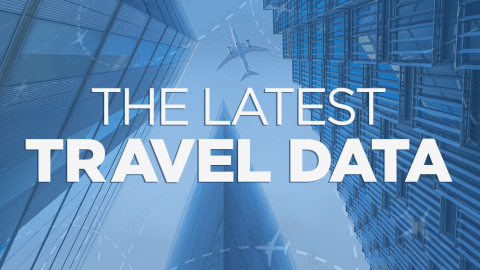
Latest Travel Data Newsletter
Our monthly data newsletter features a forward-looking outlook of the travel industry, including a summary of the latest economic, consumer and travel indicators, trends and analysis as well as key highlights from the Recovery and Growth Insights Dashboard. Member log-in required.
View the Latest Travel Data Newsletter ›
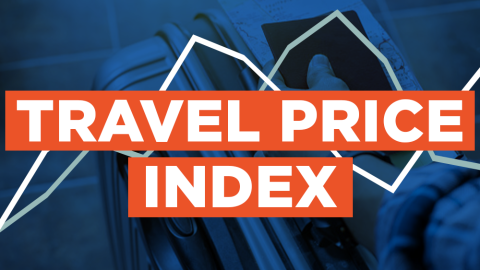
Travel Price Index (TPI)
Developed by U.S. Travel, the Travel Price Index (TPI) measures both the one-month change and 12-month change in the cost of travel away from home in the United States on a seasonally-adjusted basis. The TPI is released monthly and is directly comparable to the Consumer Price Index. Member log-in required .
View the Travel Price Index ›
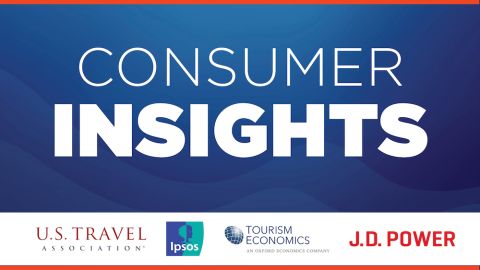
Quarterly Consumer Insights
Bringing together results from our Business Travel Tracker and Ipsos Consumer Survey, these quarterly consumer insights provide a more in-depth look at current traveler behavior and shifts in traveler trends, all within the context of an evolving macroeconomic environment.
View Quarterly Consumer Insights ›
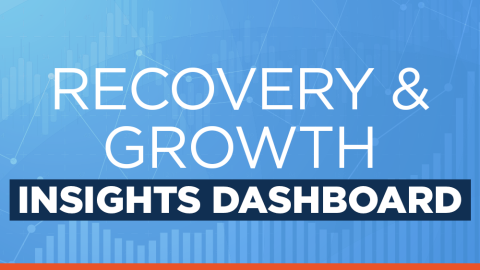
The U.S. Travel Insights Dashboard
The U.S. Travel Insights Dashboard is the most comprehensive and centralized source for high-frequency intelligence on the U.S. travel industry and broader economy. The dashboard is updated the last week of every month. Member log-in required.
View The U.S. Travel Insights Dashboard ›
Trending Research

THE ITINERARY Q3 Insights Reveal Holiday Travel Expectations and the Economic Cost of Not Addressing Traveler Pain Points

THE ITINERARY Business Travel Accelerating

THE ITINERARY The Economic Rollercoaster
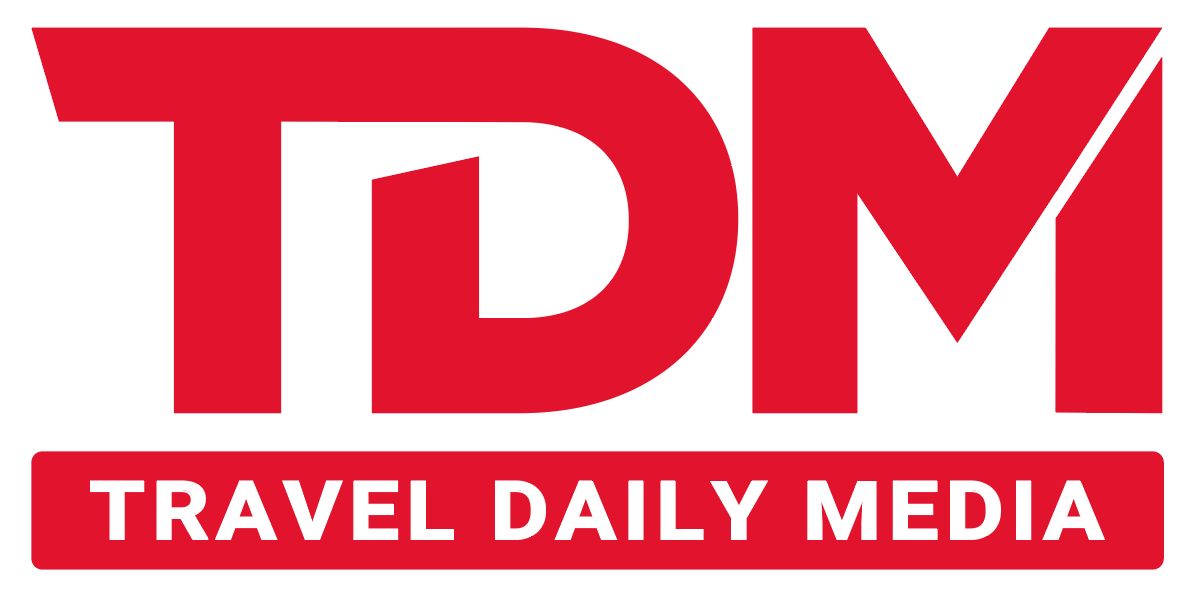
AirHelp analysis: considerations for air travel this summer
AirHelp, the travel tech company supporting passengers with flight disruptions, has unveiled Ireland’s flight data from the summer of 2022 and 2023 to help passengers prepare for and avoid disruptions . Data was collected from June, July and August across both years and analysed based on the destination country and the airline travelled with.
Summer air travel increased by one million passengers last year, from 4.7 million in 2022 to 5.7 million in 2023. Timely departures from Ireland’s airports also increased by 11% in 2023, with 66% of passengers departing on time compared to 55% in 2022. This indicates that despite the industry managing increased demand, disruption rates are gradually improving.
Across both summers, August was the best month to fly from Ireland to avoid disruptions while June was the worst. In summer 2022, 51% of passengers flying in June departed on time, compared to 54% in July and 59% in August. Last summer, 65% of those flying in June departed on time, compared to 66% in July and 67% in August.
Destination analysis
The UK was the most popular destination for passengers flying from Ireland across both summers, with 1.4 million and 1.8 million passengers having flights scheduled in 2022 and 2023, respectively. Last summer, Spain was the second most popular destination with 753,000 passengers, while the US took second place in 2022 with 533,000 passengers.
For destinations with more than 50,000 passengers each summer (excluding domestic flights), passengers flying to Turkey had the highest disruption rates in both 2022 (82%) and 2023 (66%). Those flying to Portugal had the lowest disruption rate at 37% in 2022, while passengers flying to the US were the least disrupted in 2023 at 21%. What’s more, the Netherlands had the highest rates of passengers facing cancellations in summer 2022 at 3.4%, compared to Canada at 1.9% last summer.
Airline summer performance
Ryanair was Ireland’s most popular carrier in both years, with 2 million and 2.6 million passengers in 2022 and 2023, respectively, and 53% and 62% of passengers departing on time. Looking at data from airlines that carried more than 50,000 passengers each summer, American Airlines was the least disrupted airline across both summers with 17% and 13% of passengers experiencing delays or cancellations in 2022 and 2023.
The most disrupted airline in summer 2022 was Air Canada with 91% of flights disrupted. Lufthansa was the most disrupted airline last summer, with 51% of passengers facing delays or cancellations. KLM-Royal Dutch Airlines had the highest cancellation rate in 2022, impacting 6.7% of its passengers, while passengers flying with British Airways faced the highest rate of cancellations last year, at 5%. Ryanair, on the other hand, had the lowest rate of flight cancellations despite being the largest carrier in Ireland, impacting only 0.08% of its passengers in summer 2022 and 0.5% last year.
AirHelp CEO, Tomasz Pawliszyn, comments: “Passengers have to consider a range of factors when planning their summer holidays. The most influential consideration is usually whether a service suits their budget. We urge passengers to also look at the performance of airlines and airports when booking flights and ensure they know their air passenger rights in case of disruption. With strikes set to impact airline and airport services across Ireland and the UK this summer, including upcoming Heathrow Border Force strikes, passengers need to arrive at the airport prepared for delays or cancellations, and equipped with the knowledge of how to deal with these circumstances.”
AirHelp certified in the 2024 Top 100 Most Loved Workplaces
AirHelp Analysis: Best airlines to fly with from the UK by haul
AirHelp reveals the best days and destinations to avoid disruptions ahead of the…
11 years of AirHelp: More than 2.2 million passengers claimed compensation
Since you're here...
...there are many ways you can work with us to advertise your company and connect to your customers. Our team can help you design and create an advertising campaign
We can also organize a real life or digital event for you and find thought leader speakers as well as industry leaders, who could be your potential partners, to join the event. We also run some awards programmes which give you an opportunity to be recognized for your achievements during the year and you can join this as a participant or a sponsor.
Let us help you drive your business forward with a good partnership!
Yes, contact me I want to download the media kit
Comments are closed.
LATEST STORIES

TDM interviews Deepak Ohri, Founder & CEO at Luxury Atelier Maison Happiness (LAMH) & Management Asia

TDM interviews Carlos Munoz, Chief Commercial Officer HBX

TDM interviews Pippa Williamson, Vice President Commercial Hotelbeds

Farnborough Airport completes £3 million state-of-the-art security upgrade
Welcome, Login to your account.
Sign in with Google
Powered by wp-glogin.com
Recover your password.
A password will be e-mailed to you.
Welcome back, Log in to your account.
SIGN UP FOR FREE
Be part of our community of seasoned travel and hospitality industry professionals from all over the world.
- LOGIN / SIGN UP
- Middle East
- UK & Europe
- USA & Canada
- Hospitality
- HR & Careers
- Luxury Travel
- MICE (Meetings, Incentives, Conferencing, Exhibitions)
- Travel Tech
- Travel Agents
- Airlines / Airports
- Conferences
- Cruising (Ocean)
- Cruising (River)
- Destination Management (DMC)
- Hotels & Resorts
- Hotel Management Company
- Hotel Technology
- HR / Appointments
- Meetings, Incentives, Conferencing, Exhibitions (MICE)
- Travel Agents (all)
- Travel Technology
- Tourism Boards
- TDM Travel Show
- Industry appointments
- Travel Bloggers
- Podcasts – Features
- How to join
- RSVP Portal
- Event Photos/Videos
- Competitions
- Travel Club
- Middle East September 2024
- Thailand October 2024
- Destination NaJomtien BanAmphur BangSaray *NEW*
- จุดหมายปลายทาง นาจอมเทียน หาดบ้านอำเภอ บางเสร่ *NEW*
- South Australia Reward Wonders *NEW*
- Ponant Yacht Cruises and Expeditions
- Encore Tickets (Chinese Guide)
- Affordable Luxury in Thailand by Centara Hotels
- Rising Above the Oridinary by Conrad Bangkok
- The Best of Thailand
- Who is IWTA
- Philippines
- Recommend Someone
- Recommend yourself
- IWTA Awards

Women and children of Gaza are killed less frequently as war’s toll rises, AP data analysis finds

The proportion of Palestinian women and children being killed in the Israel-Hamas war appears to have declined sharply, an Associated Press analysis of Gaza Health Ministry data has found, a trend that both coincides with Israel’s changing battlefield tactics and contradicts the ministry’s own public statements.
The trend is significant because the death rate for women and children is the best available proxy for civilian casualties in one of the 21st century’s most destructive conflicts. In October, when the war began, it was above 60%. For the month of April, it was below 40%. Yet the shift went unnoticed for months by the U.N. and much of the media, and the Hamas-linked Health Ministry has made no effort to set the record straight.
Israel faces heavy international criticism over unprecedented levels of civilian casualties in Gaza and questions about whether it has done enough to prevent them in an 8-month-old war that shows no sign of ending. Two recent airstrikes in Gaza killed dozens of civilians.
The AP analysis highlights facts that have been overlooked and could help inform the public debate, said Gabriel Epstein, a research assistant at the Washington Institute for Near East policy who has also studied the Health Ministry data.
The declining impact on women and children -- as well as a drop in the overall death rate -- are “definitely due to a change in the way the IDF is acting right now,” Epstein said, using an acronym for the Israeli army. “That’s an easy conclusion, but I don’t think it’s been made enough.”
Omar Shakir, the Israel and Palestine director for Human Rights Watch, said his group has always found the Health Ministry’s numbers to be “generally reliable” because it has direct access to hospitals and morgues.
Whatever the reason for fewer women and child being killed, Shakir said, in the grand scheme, the trend pales when compared with the war’s overall devastation. “The death toll may be an undercount,” he added, because many bodies are still under rubble and the war has made it difficult for the Health Ministry to comprehensively gather data.

Israel at War
Over 30 dead in Israeli strike overnight in Gaza
AS THE WAR EVOLVES, A SHIFT OCCURS
When Israel first responded to Hamas’ Oct. 7 attack, which killed some 1,200 people, it launched an intense aerial bombardment on the densely populated Gaza Strip. Israel said its goal was to destroy Hamas positions, and the barrage cleared the way for tens of thousands of ground troops, backed by tanks and artillery.
The Gaza death toll rose quickly and by the end of October women and people 17 and younger accounted for 64% of the 6,745 killed who were fully identified by the Health Ministry.
After marching across most of Gaza and saying it had achieved many key objectives, Israel then began withdrawing most of its ground forces. It reduced the frequency of aerial bombings and has focused in recent months on smaller drone strikes and limited ground operations.
As the intensity of fighting has scaled back, the death toll has continued to rise, but at a slower rate – and with seemingly fewer civilians caught in the crossfire. In April, women and children made up 38% of the newly and fully identified deaths, the Health Ministry’s most recent data shows.
“Historically, airstrikes (kill) a higher ratio of women and children compared to ground operations,” said Larry Lewis, an expert on the civilian impacts of war at CNA, a nonprofit research group in Washington. The findings of the AP analysis “make sense,” he said.
Another sign that Israel softened its bombing campaign: Beginning in January, there was a sharp slowdown in “new damage” to buildings in Gaza, according to Corey Scher, a satellite mapping expert at City University of New York who has monitored buildings damaged or destroyed since the war began.

Israeli ground forces launch new incursion into a central Gaza refugee camp
DAILY DEATH TOLLS AT ODDS WITH UNDERLYING DATA
The Health Ministry announces a new death toll for the war nearly every day. It also has periodically released the underlying data behind this figure, including detailed lists of the dead.
The AP’s analysis looked at these lists, which were shared on social media in late October, early January, late March, and the end of April. Each list includes the names of people whose deaths were attributable to the war, along with other identifying details.
The daily death tolls, however, are provided without supporting data. In February, ministry officials said 75% of the dead were women and children – a level that was never confirmed in the detailed reports. And as recently as March, the ministry’s daily reports claimed that 72% of the dead were women and children, even as underlying data clearly showed the percentage was well below that.
Israeli leaders have pointed to such inconsistencies as evidence that the ministry, which is led by medical professionals but reports to Gaza’s Hamas government, is inflating the figures for political gain.
Experts say the reality is more complicated, given the scale of devastation that has overwhelmed and badly damaged Gaza’s hospital system.
Lewis said while the “beleaguered” Health Ministry has come under heavy scrutiny, Israel has yet to provide credible alternative data. He called on Israel to “put out your numbers.”
HIGH CIVILIAN DEATH TOLL IS A LIABILITY FOR ISRAEL
The true toll in Gaza could have serious repercussions. Two international courts in the Hague are examining accusations that Israel has committed war crimes and genocide against Palestinians – allegations it adamantly denies.
Israel has opened a potentially devastating new phase of the war in the southern Gaza city of Rafah, where an estimated 100,000 civilians remain even after mass evacuations. How Israel mitigates civilian deaths there will be closely watched.
Israeli airstrikes in Rafah last month set off a fire that killed dozens of people, and on Thursday an airstrike on a school-turned-shelter in central Gaza killed at least 33 people, including 12 women and children, local health officials said.
Israel says it has tried to avoid civilian casualties throughout the war, including by issuing mass evacuation orders ahead of intense military operations that have displaced some 80% of Gaza’s population. It also accuses Hamas of intentionally putting civilians in harm’s way as human shields.
The U.N. secretary-general plans to list Israel and Hamas as violating the rights and protection of children in armed conflict in an upcoming annual report to the Security Council.
The fate of women and children is an important indicator of civilian casualties because the Health Ministry does not break out combatant deaths. But it’s not a perfect indicator: Many civilian men have died, and some older teenagers may be involved in the fighting.
PARSING GAZA HEALTH MINISTRY DATA
The ministry said publicly on April 30 that 34,622 had died in the war. The AP analysis was based on the 22,961 individuals fully identified at the time by the Health Ministry with names, genders, ages, and Israeli-issued identification numbers.
The ministry says 9,940 of the dead – 29% of its April 30 total – were not listed in the data because they remain “unidentified.” These include bodies not claimed by families, decomposed beyond recognition or whose records were lost in Israeli raids on hospitals.
An additional 1,699 records in the ministry’s April data were incomplete and 22 were duplicates; they were excluded from AP’s analysis.
Among those fully identified, the records show a steady decline in the overall proportion of women and children who have been killed: from 64% in late October, to 62% as of early January, to 57% by the end of March, to 54% by the end of April.
Yet throughout the war, the ministry has claimed that roughly two-thirds of the dead were women and children. This figure has been repeated by international organizations and many in the foreign media, including the AP.
The Health Ministry says it has gone to great lengths to accurately compile information but that its ability to count and identify the dead has been greatly hampered by the war. The fighting has crippled the Gaza health system, knocking out two-thirds of the territory’s 36 hospitals, closing morgues and hampering the work of facilities still functioning.
Dr. Moatasem Salah, director of the ministry’s emergency center, rejected Israeli assertions that his ministry has intentionally inflated or manipulated the death toll.
“This shows disrespect to the humanity for any person who exists here,” he said. “We are not numbers … These are all human souls.”
He insisted that 70% of those killed have been women and children and said the overall death toll is much higher than what has been reported because thousands of people remain missing, are believed to be buried in rubble, or their deaths were not reported by their families.
AS DEATH TOLL RISES, THE DETAILS ARE DEBATED
To be sure, this war’s death toll is the highest of any previous Israel-Palestinian conflict. But Israeli leaders say the international media and United Nations have cited Palestinian figures without a critical eye.
Israel last month angrily criticized the U.N.’s use of data from Hamas’ media office – a propaganda arm of the militant group – that reported a larger number of women and children killed. The U.N. later lowered its number in line with Health Ministry figures.
Israel’s foreign minister, Israel Katz, lashed out on the social platform X: “Anyone who relies on fake data from a terrorist organization in order to promote blood libels against Israel is antisemitic and supports terrorism.”
AP’s examination of the reports found flaws in the Palestinian record keeping. As Gaza’s hospital system collapsed in December and January, the ministry began relying on hard-to-verify “media reports” to register new deaths. Its March report included 531 individuals who were counted twice, and many deaths were self-reported by families, instead of health officials.
Epstein, the Washington Institute researcher, said using different data-collection methodologies and then combining all the numbers gives an inaccurate picture.
“That’s probably the biggest problem,” he said, adding that he was surprised there hadn’t been more scrutiny.
The number of Hamas militants killed in the fighting is also unclear. Hamas has closely guarded this information, though Khalil al-Hayya, a top Hamas official, told the AP in late April that the group had lost no more than 20% of its fighters. That would amount to roughly 6,000 fighters based on Israeli pre-war estimates.
The Israeli military has not challenged the overall death toll released by the Palestinian ministry. But it says the number of dead militants is much higher at roughly 15,000 – or over 40% of all the dead. It has provided no evidence to support the claim, and declined to comment for this story.
Shlomo Mofaz, director of Israel’s Meir Amit Intelligence and Terrorism Information Center, said such estimates are typically based on body counts, battlefield intelligence and the interrogations of captured Hamas commanders.
Mofaz, a former Israeli intelligence officer, said his researchers are skeptical of the Palestinian data.
In previous conflicts, he said his researchers found numerous “inconsistencies,” such as including natural deaths from disease or car accidents among the war casualties. He expects that to be the case this time as well. The large number of unidentified dead raises further questions, he said.
Michael Spagat, a London-based economics professor who chairs the board of Every Casualty Counts, a nonprofit that tracks armed conflicts, said he continues to trust the Health Ministry and believes it is doing its best in difficult circumstances.
“I think (the data) becomes increasingly flawed,” he said. But, he added, “the flaws don’t necessarily change the overall picture.”
Most Recent

'Roaring Kitty' YouTube livestream and Gamestop's rough day on Wall Street

How tech companies like Meta and Google are increasingly adding AI to apps

Some medications may increase your risk of heat illness

Virtual kidnapping scams have targeted international students, police warn

Biden recalls the actions of those who stormed Normandy 80 years after D-Day

Yemen's Houthi rebels detain at least 9 UN staffers, others in sudden crackdown

Watch Scripps News

IMAGES
VIDEO
COMMENTS
As an industry with tight margins, travel and tourism companies can use analytics to detect trends that help them reduce costs, decide future product and service offerings, and develop successful business strategies. For example, companies in this vertical can use big data and analytics to: Forecast customer demands. Personalize services.
Big data analysis is essential for this. By analyzing data about pricing, occupancy rates, current bookings, seasonal trends, local events and holidays, travel-related companies can more accurately predict demand and price their products accordingly. Hotels can adjust room rates on a day-to-day basis.
Types of Big Data Analytics in the Tourism Industry. There are four primary types of data analysis: Descriptive Analytics: Focuses on past events, leveraging historical data to identify trends and relationships. Predictive Analytics: Uses data, modeling, and machine learning (ML) to analyze current and historical data to make predictions about ...
Exploring data analytics in travel: key use cases, travel data sources and providers, real-world examples, and the guide to approaching travel analytics. ... The next crucial phase is to gather the necessary data for analysis. The choice of data sources and collection methods should align with business objectives to ensure that the analysis is ...
Grow with Google. Explore free training, tools and resources to grow your skills. *All data is indexed. This tool uses search volume as a proxy for travel demand. Monitor travel trends. See the latest data and insights around destinations that travellers are searching out - and get tools, advice and tips for making your business stand out online.
Sentiment analysis, a type of data analysis, can categorize this feedback into positive, neutral, or negative sentiments, helping identify patterns and themes. Travel companies can then address the concerns raised, enhancing the quality of their service and improving customer satisfaction, which leads to increased customer retention. 5.
Enhanced analytics. Big data in tourism involves the use of historical and real-time data. At the same time, standard analytical approaches use only historical one. This is why big data solutions are more effective at predicting when trends change dramatically (as was the case with the COVID-19 pandemic, for example).
Welcome to "Navigating the Data Highway: A Comprehensive Guide to Data Analytics in the Travel Industry," where we unravel the transformative power of data in shaping our journeys. In today's dynamic travel landscape, stakeholders across the industry are realizing that knowledge truly is power, and data serves as the fuel for informed decision-making.
Learn how Tableau helps travel and transportation companies to blend and link data, optimize revenue and profitability, and drive customer loyalty. See customer stories, presentations, and resources from Skyscanner, Lufthansa, Aer Lingus, and more.
Role in Travel Analytics: Microsoft Power BI offers a comprehensive suite of BI tools, enabling practical analysis and visualization of travel data. Its seamless integration with various data sources enhances its utility in the travel industry. Suitability: Power BI's versatility makes it suitable for companies focusing on customization.
3. Predictive Analytics. Predictive analytics is the most advanced form of corporate data analytics. It uses deep learning and machine learning algorithms to detect patterns in travel data and make predictions. Therefore, you can use predictive analytics can get the best future course of action based on past trends.
Big data and data analytics are most commonly tied with industries such as fintech and IT.However, a few years ago, they also made it into the travel sector. They didn't just make it into the industry. The enormous adoption rates of data analytics in the sector have created a brand new market - the tourism industry and the big data analytics market.
Overspending: Travel analytics could help your company identify specific travelers who regularly overspend. Total Trip Cost: Travel analytics can pull data from multiple sources, making it possible to create a total trip cost for comparison against compliance and creation of a trip's ROI. Real-Time Tracking: We all have budgets.
Sentiment is also growing for upcoming leisure travel in 2024. The share of travelers reporting having travel plans within the next six months increased to 93% in January from 92% in December, according to Longwoods International's monthly survey. Travel price inflation (TPI) fell slightly in January as a result of falling transportation prices.
Business Data Analytics in Travel Industry. Machine Learning and Artificial Intelligence are picking up traction in the travel industry to help airlines and hotels make data-driven decisions based on accurate and actionable insights. Business analytics provide real-time insights about customers using data from multiple sources. Data like flight bookings, hotel stays, schedule patterns, repeat ...
INTERACTIVE TRAVEL DATA May 09, 2024. The U.S. Travel Insights Dashboard. ... Monthly member-exclusive summary of the latest economic, consumer and travel indicators, trends and analysis featuring key highlights from the U.S. Travel Insights Dashboard. REPORT February 07, 2024.
Numerous businesses and organizations in the travel industry rely on the independent analyses of Travel Data + Analytics, as it is the only instrument depicting the German travel market in a market-representative manner on the basis of real booking data and professional projection methods with highest data quality. More about TDA.
The rest of this article is organized as follows: In Section 2, the major problems addressed by the surveyed papers are briefly presented.Section 3 discusses various data analytics approaches and ML techniques that have been used in the airline industry to complement traditional statistical analytics. Since the airlines' data is mostly private and contain a lot of non-disclosure information ...
To convert inspiration to bookings, businesses need to ensure they meet travelers' needs. 13%. The average traveler spends 13% of their time online conducting travel-related activities. Google/Bain. 47%. of people surveyed say they didn't make a booking online when they intended to because it didn't meet their needs. Google/Bain. 26%.
Data Analyst - Travel Demand Modeler. ... Strong data analysis background, ability to integrate data, correlate and find data trends, must be analytical; Experience working with internal clients at various levels of the organization with an ability to communicate clearly and develop relationships with business partners;
The UN Tourism Data Dashboard - provides statistics and insights on key indicators for inbound and outbound tourism at the global, regional and national levels. ... The first one-stop-shop for global information on COVID-19 related travel regulations it aims to build confidence among travellers and business and support policy making by ...
Travel and Tourism Satellite Account for 2018-2022 The travel and tourism industry—as measured by the real output of goods and services sold directly to visitors—increased 21.0 percent in 2022 after increasing 53.6 percent in 2021, according to the most recent statistics from BEA's Travel and Tourism Sate
By 2026, market value is projected to reach $662.63 billion (CAGR 2023-26: 7.98%) as travelers increasingly switch to online travel intermediaries over in-store travel agents.
Kaggle uses cookies from Google to deliver and enhance the quality of its services and to analyze traffic.
Leisure travelers are increasingly using generative AI tools for trip inspiration and itinerary planning. The most enthusiastic adopters tend to be younger, elite loyalty members, and people who like to take cruises.; Generative AI has the capabilities to address existing trip inspiration and travel planning pain points for consumers, and users are recognizing that.
Latest Travel Data Newsletter. Our monthly data newsletter features a forward-looking outlook of the travel industry, including a summary of the latest economic, consumer and travel indicators, trends and analysis as well as key highlights from the Recovery and Growth Insights Dashboard.
AirHelp, the travel tech company supporting passengers with flight disruptions, has unveiled Ireland's flight data from the summer of 2022 and 2023 to help passengers prepare for and avoid ...
The average cost of travel insurance is 5% to 6% of your trip costs, according to Forbes Advisor's analysis of travel insurance rates. For a $5,000 trip, the average travel insurance cost is ...
An additional 1,699 records in the ministry's April data were incomplete and 22 were duplicates; they were excluded from AP's analysis. Among those fully identified, the records show a steady decline in the overall proportion of women and children who have been killed: from 64% in late October, to 62% as of early January, to 57% by the end ...
Demand for air travel continues to rise in April. Industry total Revenue Passenger-Kilometers (RPK) in April grew 11.0% annually, led by stronger international traffic. Passenger load factors (PLF) remained higher than previous years, reaching 82.4%. Domestic traffic kept increasing in April, at 4.0% Year-on-Year (YoY).